Asthma: Pathophysiological Changes, Nursing Interventions, and Symptoms
VerifiedAdded on 2023/04/21
|23
|7045
|400
AI Summary
This document discusses the pathophysiological changes that occur during an asthma attack, as well as the nursing interventions and symptoms associated with ineffective airway clearance, ineffective breathing pattern, impaired gas exchange, fatigue, activity intolerance, anxiety, and imbalanced nutrition. It also provides information on the physical assessment of a patient with asthma and the appropriate nursing actions to implement during an asthma attack. Additionally, it covers the education that should be provided to patients and their families, as well as the involvement of other healthcare professionals in the holistic care of patients with asthma. Lastly, it discusses the differences between stable and unstable angina, and the immediate nursing actions to manage a patient with chest pain.
Contribute Materials
Your contribution can guide someone’s learning journey. Share your
documents today.
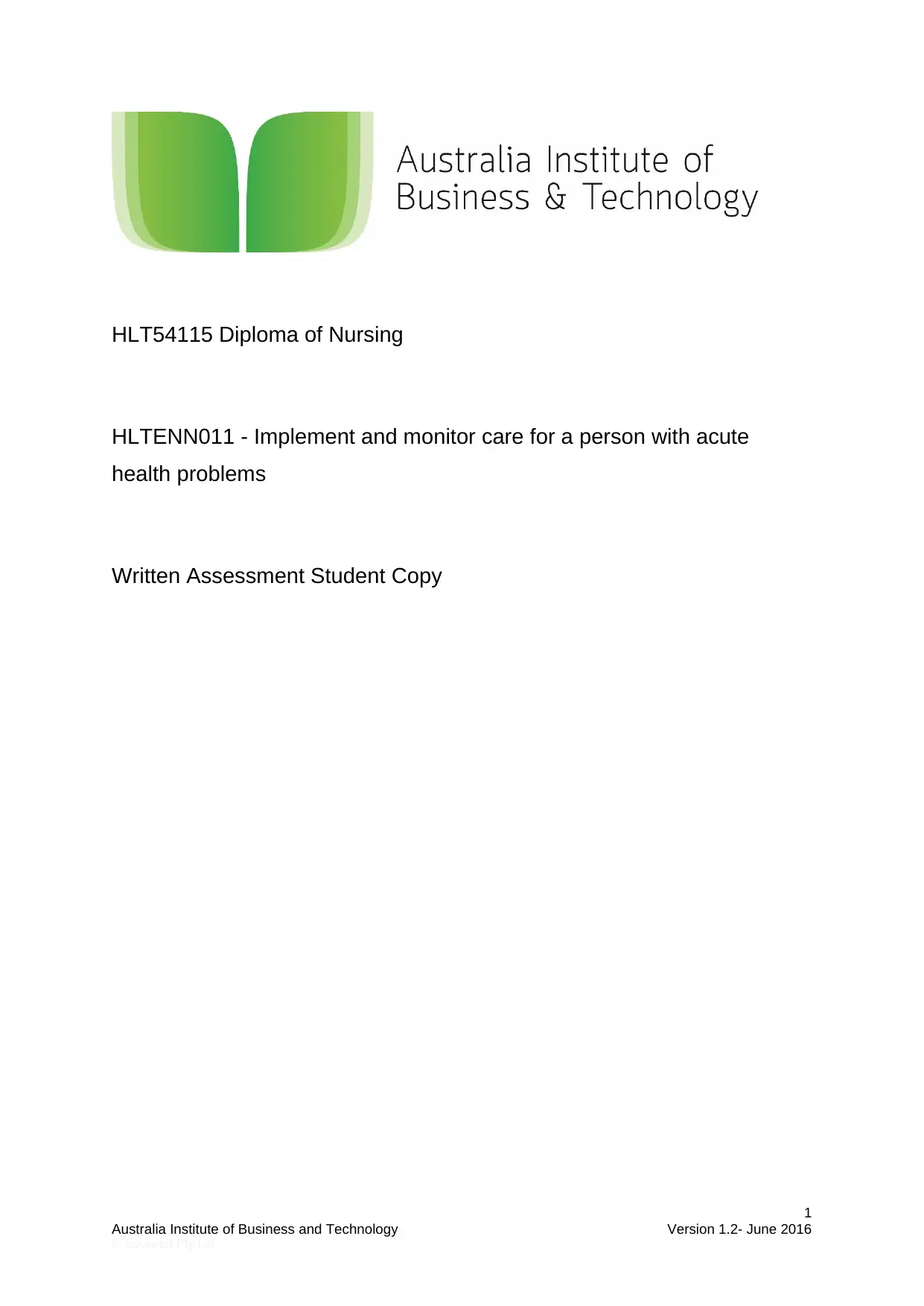
HLT54115 Diploma of Nursing
HLTENN011 - Implement and monitor care for a person with acute
health problems
Written Assessment Student Copy
1
Australia Institute of Business and Technology Version 1.2- June 2016
© Succeed Pty Ltd
HLTENN011 - Implement and monitor care for a person with acute
health problems
Written Assessment Student Copy
1
Australia Institute of Business and Technology Version 1.2- June 2016
© Succeed Pty Ltd
Secure Best Marks with AI Grader
Need help grading? Try our AI Grader for instant feedback on your assignments.
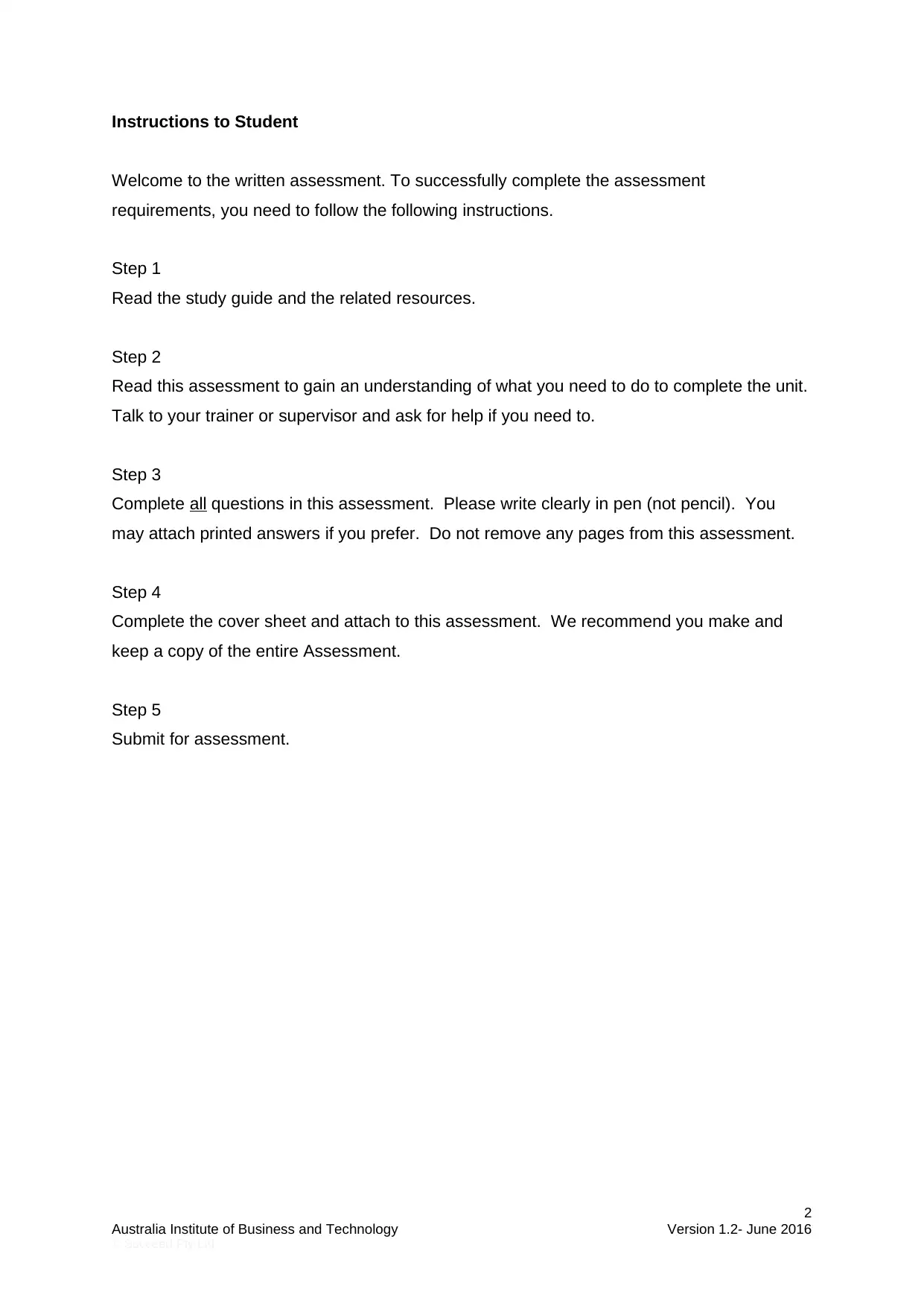
Instructions to Student
Welcome to the written assessment. To successfully complete the assessment
requirements, you need to follow the following instructions.
Step 1
Read the study guide and the related resources.
Step 2
Read this assessment to gain an understanding of what you need to do to complete the unit.
Talk to your trainer or supervisor and ask for help if you need to.
Step 3
Complete all questions in this assessment. Please write clearly in pen (not pencil). You
may attach printed answers if you prefer. Do not remove any pages from this assessment.
Step 4
Complete the cover sheet and attach to this assessment. We recommend you make and
keep a copy of the entire Assessment.
Step 5
Submit for assessment.
2
Australia Institute of Business and Technology Version 1.2- June 2016
© Succeed Pty Ltd
Welcome to the written assessment. To successfully complete the assessment
requirements, you need to follow the following instructions.
Step 1
Read the study guide and the related resources.
Step 2
Read this assessment to gain an understanding of what you need to do to complete the unit.
Talk to your trainer or supervisor and ask for help if you need to.
Step 3
Complete all questions in this assessment. Please write clearly in pen (not pencil). You
may attach printed answers if you prefer. Do not remove any pages from this assessment.
Step 4
Complete the cover sheet and attach to this assessment. We recommend you make and
keep a copy of the entire Assessment.
Step 5
Submit for assessment.
2
Australia Institute of Business and Technology Version 1.2- June 2016
© Succeed Pty Ltd
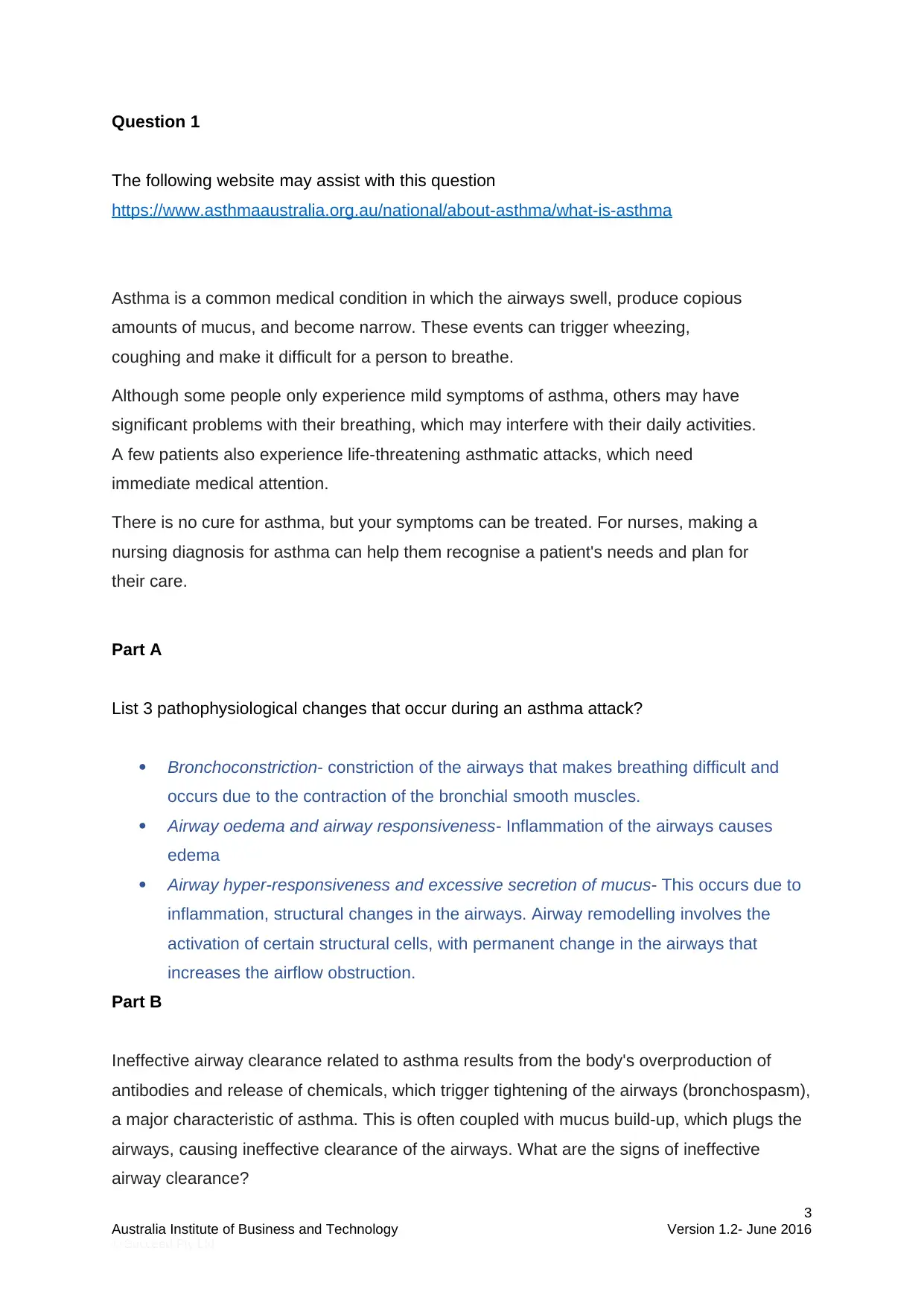
Question 1
The following website may assist with this question
https://www.asthmaaustralia.org.au/national/about-asthma/what-is-asthma
Asthma is a common medical condition in which the airways swell, produce copious
amounts of mucus, and become narrow. These events can trigger wheezing,
coughing and make it difficult for a person to breathe.
Although some people only experience mild symptoms of asthma, others may have
significant problems with their breathing, which may interfere with their daily activities.
A few patients also experience life-threatening asthmatic attacks, which need
immediate medical attention.
There is no cure for asthma, but your symptoms can be treated. For nurses, making a
nursing diagnosis for asthma can help them recognise a patient's needs and plan for
their care.
Part A
List 3 pathophysiological changes that occur during an asthma attack?
Bronchoconstriction- constriction of the airways that makes breathing difficult and
occurs due to the contraction of the bronchial smooth muscles.
Airway oedema and airway responsiveness- Inflammation of the airways causes
edema
Airway hyper-responsiveness and excessive secretion of mucus- This occurs due to
inflammation, structural changes in the airways. Airway remodelling involves the
activation of certain structural cells, with permanent change in the airways that
increases the airflow obstruction.
Part B
Ineffective airway clearance related to asthma results from the body's overproduction of
antibodies and release of chemicals, which trigger tightening of the airways (bronchospasm),
a major characteristic of asthma. This is often coupled with mucus build-up, which plugs the
airways, causing ineffective clearance of the airways. What are the signs of ineffective
airway clearance?
3
Australia Institute of Business and Technology Version 1.2- June 2016
© Succeed Pty Ltd
The following website may assist with this question
https://www.asthmaaustralia.org.au/national/about-asthma/what-is-asthma
Asthma is a common medical condition in which the airways swell, produce copious
amounts of mucus, and become narrow. These events can trigger wheezing,
coughing and make it difficult for a person to breathe.
Although some people only experience mild symptoms of asthma, others may have
significant problems with their breathing, which may interfere with their daily activities.
A few patients also experience life-threatening asthmatic attacks, which need
immediate medical attention.
There is no cure for asthma, but your symptoms can be treated. For nurses, making a
nursing diagnosis for asthma can help them recognise a patient's needs and plan for
their care.
Part A
List 3 pathophysiological changes that occur during an asthma attack?
Bronchoconstriction- constriction of the airways that makes breathing difficult and
occurs due to the contraction of the bronchial smooth muscles.
Airway oedema and airway responsiveness- Inflammation of the airways causes
edema
Airway hyper-responsiveness and excessive secretion of mucus- This occurs due to
inflammation, structural changes in the airways. Airway remodelling involves the
activation of certain structural cells, with permanent change in the airways that
increases the airflow obstruction.
Part B
Ineffective airway clearance related to asthma results from the body's overproduction of
antibodies and release of chemicals, which trigger tightening of the airways (bronchospasm),
a major characteristic of asthma. This is often coupled with mucus build-up, which plugs the
airways, causing ineffective clearance of the airways. What are the signs of ineffective
airway clearance?
3
Australia Institute of Business and Technology Version 1.2- June 2016
© Succeed Pty Ltd
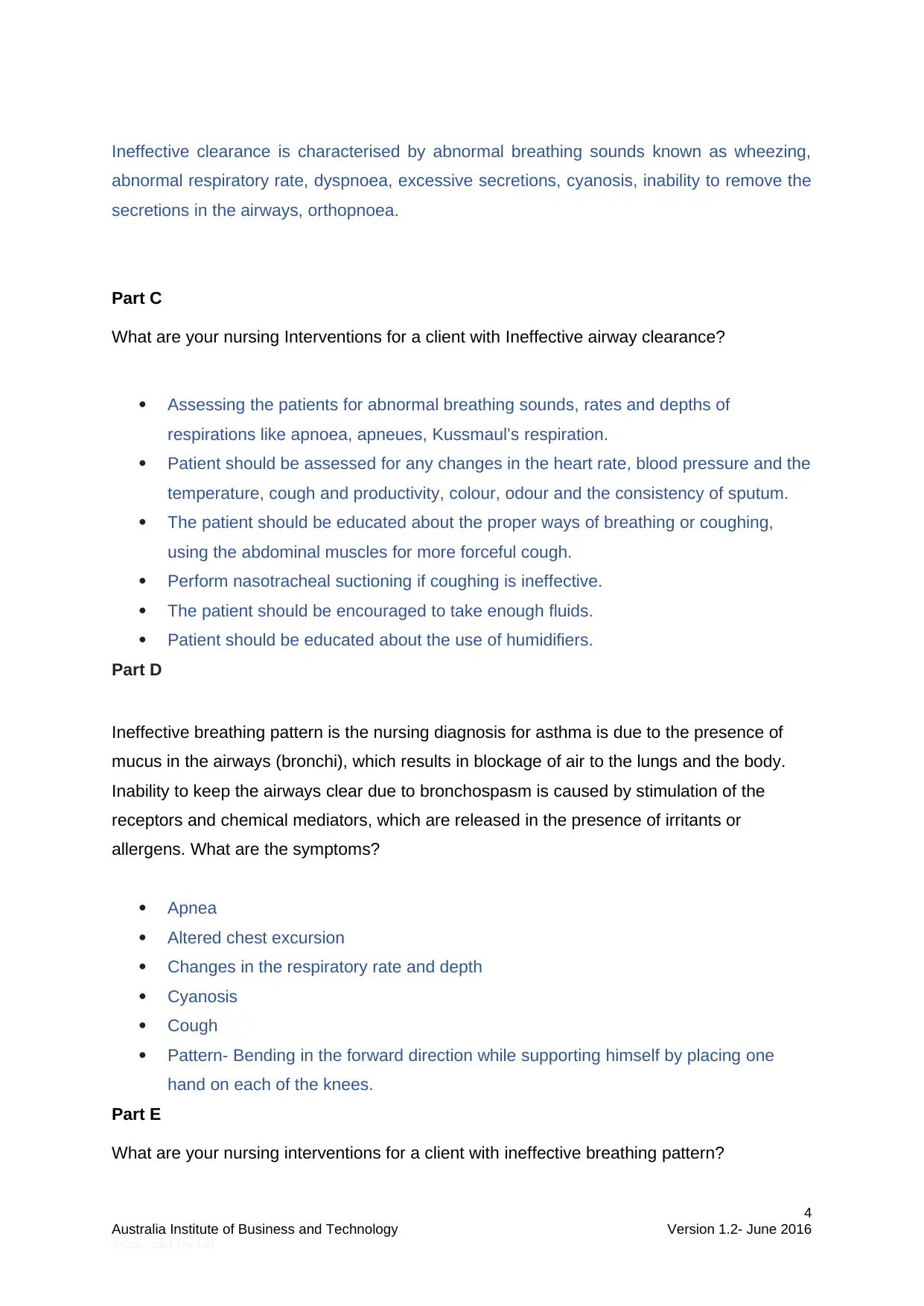
Ineffective clearance is characterised by abnormal breathing sounds known as wheezing,
abnormal respiratory rate, dyspnoea, excessive secretions, cyanosis, inability to remove the
secretions in the airways, orthopnoea.
Part C
What are your nursing Interventions for a client with Ineffective airway clearance?
Assessing the patients for abnormal breathing sounds, rates and depths of
respirations like apnoea, apneues, Kussmaul’s respiration.
Patient should be assessed for any changes in the heart rate, blood pressure and the
temperature, cough and productivity, colour, odour and the consistency of sputum.
The patient should be educated about the proper ways of breathing or coughing,
using the abdominal muscles for more forceful cough.
Perform nasotracheal suctioning if coughing is ineffective.
The patient should be encouraged to take enough fluids.
Patient should be educated about the use of humidifiers.
Part D
Ineffective breathing pattern is the nursing diagnosis for asthma is due to the presence of
mucus in the airways (bronchi), which results in blockage of air to the lungs and the body.
Inability to keep the airways clear due to bronchospasm is caused by stimulation of the
receptors and chemical mediators, which are released in the presence of irritants or
allergens. What are the symptoms?
Apnea
Altered chest excursion
Changes in the respiratory rate and depth
Cyanosis
Cough
Pattern- Bending in the forward direction while supporting himself by placing one
hand on each of the knees.
Part E
What are your nursing interventions for a client with ineffective breathing pattern?
4
Australia Institute of Business and Technology Version 1.2- June 2016
© Succeed Pty Ltd
abnormal respiratory rate, dyspnoea, excessive secretions, cyanosis, inability to remove the
secretions in the airways, orthopnoea.
Part C
What are your nursing Interventions for a client with Ineffective airway clearance?
Assessing the patients for abnormal breathing sounds, rates and depths of
respirations like apnoea, apneues, Kussmaul’s respiration.
Patient should be assessed for any changes in the heart rate, blood pressure and the
temperature, cough and productivity, colour, odour and the consistency of sputum.
The patient should be educated about the proper ways of breathing or coughing,
using the abdominal muscles for more forceful cough.
Perform nasotracheal suctioning if coughing is ineffective.
The patient should be encouraged to take enough fluids.
Patient should be educated about the use of humidifiers.
Part D
Ineffective breathing pattern is the nursing diagnosis for asthma is due to the presence of
mucus in the airways (bronchi), which results in blockage of air to the lungs and the body.
Inability to keep the airways clear due to bronchospasm is caused by stimulation of the
receptors and chemical mediators, which are released in the presence of irritants or
allergens. What are the symptoms?
Apnea
Altered chest excursion
Changes in the respiratory rate and depth
Cyanosis
Cough
Pattern- Bending in the forward direction while supporting himself by placing one
hand on each of the knees.
Part E
What are your nursing interventions for a client with ineffective breathing pattern?
4
Australia Institute of Business and Technology Version 1.2- June 2016
© Succeed Pty Ltd
Paraphrase This Document
Need a fresh take? Get an instant paraphrase of this document with our AI Paraphraser
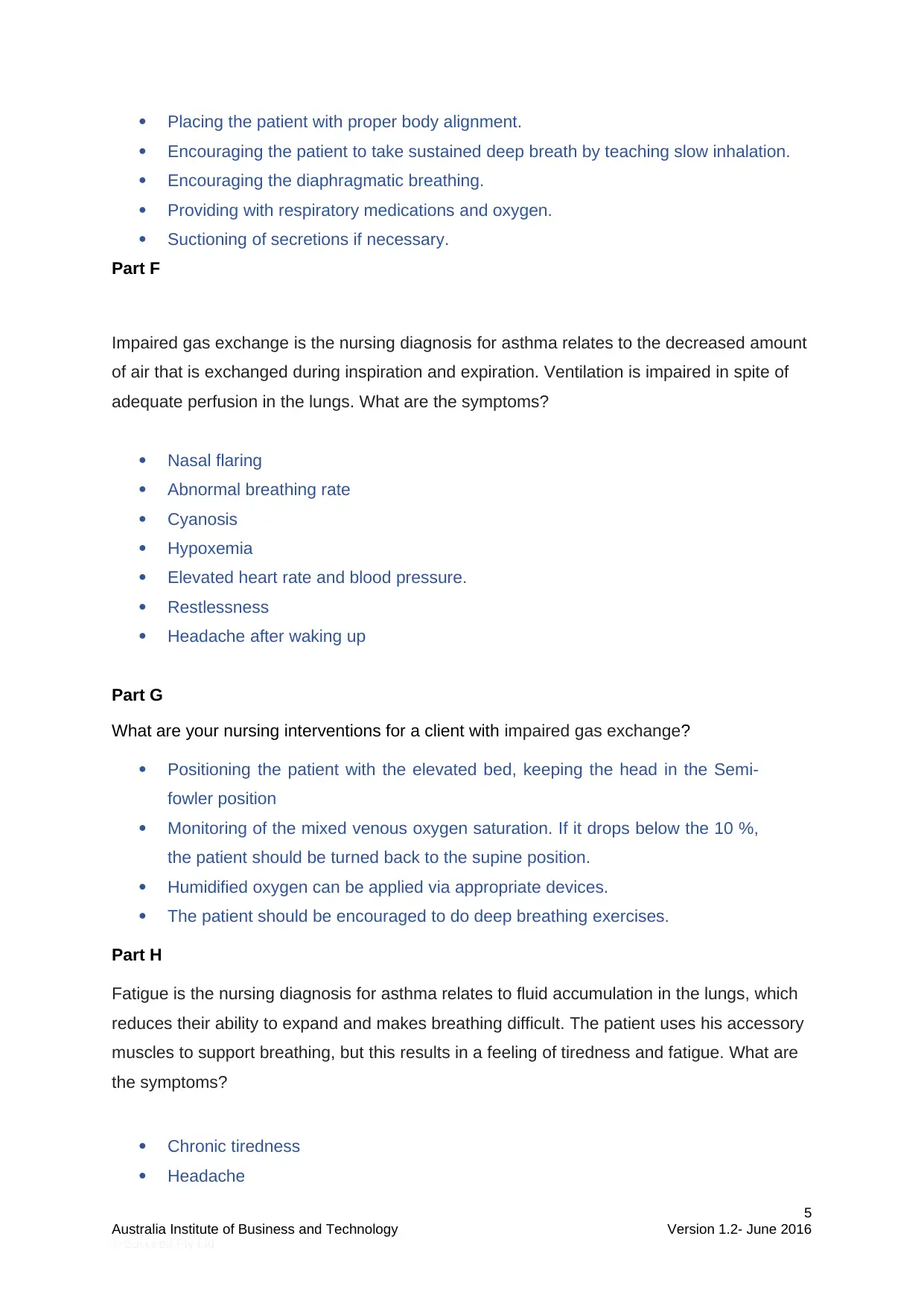
Placing the patient with proper body alignment.
Encouraging the patient to take sustained deep breath by teaching slow inhalation.
Encouraging the diaphragmatic breathing.
Providing with respiratory medications and oxygen.
Suctioning of secretions if necessary.
Part F
Impaired gas exchange is the nursing diagnosis for asthma relates to the decreased amount
of air that is exchanged during inspiration and expiration. Ventilation is impaired in spite of
adequate perfusion in the lungs. What are the symptoms?
Nasal flaring
Abnormal breathing rate
Cyanosis
Hypoxemia
Elevated heart rate and blood pressure.
Restlessness
Headache after waking up
Part G
What are your nursing interventions for a client with impaired gas exchange?
Positioning the patient with the elevated bed, keeping the head in the Semi-
fowler position
Monitoring of the mixed venous oxygen saturation. If it drops below the 10 %,
the patient should be turned back to the supine position.
Humidified oxygen can be applied via appropriate devices.
The patient should be encouraged to do deep breathing exercises.
Part H
Fatigue is the nursing diagnosis for asthma relates to fluid accumulation in the lungs, which
reduces their ability to expand and makes breathing difficult. The patient uses his accessory
muscles to support breathing, but this results in a feeling of tiredness and fatigue. What are
the symptoms?
Chronic tiredness
Headache
5
Australia Institute of Business and Technology Version 1.2- June 2016
© Succeed Pty Ltd
Encouraging the patient to take sustained deep breath by teaching slow inhalation.
Encouraging the diaphragmatic breathing.
Providing with respiratory medications and oxygen.
Suctioning of secretions if necessary.
Part F
Impaired gas exchange is the nursing diagnosis for asthma relates to the decreased amount
of air that is exchanged during inspiration and expiration. Ventilation is impaired in spite of
adequate perfusion in the lungs. What are the symptoms?
Nasal flaring
Abnormal breathing rate
Cyanosis
Hypoxemia
Elevated heart rate and blood pressure.
Restlessness
Headache after waking up
Part G
What are your nursing interventions for a client with impaired gas exchange?
Positioning the patient with the elevated bed, keeping the head in the Semi-
fowler position
Monitoring of the mixed venous oxygen saturation. If it drops below the 10 %,
the patient should be turned back to the supine position.
Humidified oxygen can be applied via appropriate devices.
The patient should be encouraged to do deep breathing exercises.
Part H
Fatigue is the nursing diagnosis for asthma relates to fluid accumulation in the lungs, which
reduces their ability to expand and makes breathing difficult. The patient uses his accessory
muscles to support breathing, but this results in a feeling of tiredness and fatigue. What are
the symptoms?
Chronic tiredness
Headache
5
Australia Institute of Business and Technology Version 1.2- June 2016
© Succeed Pty Ltd
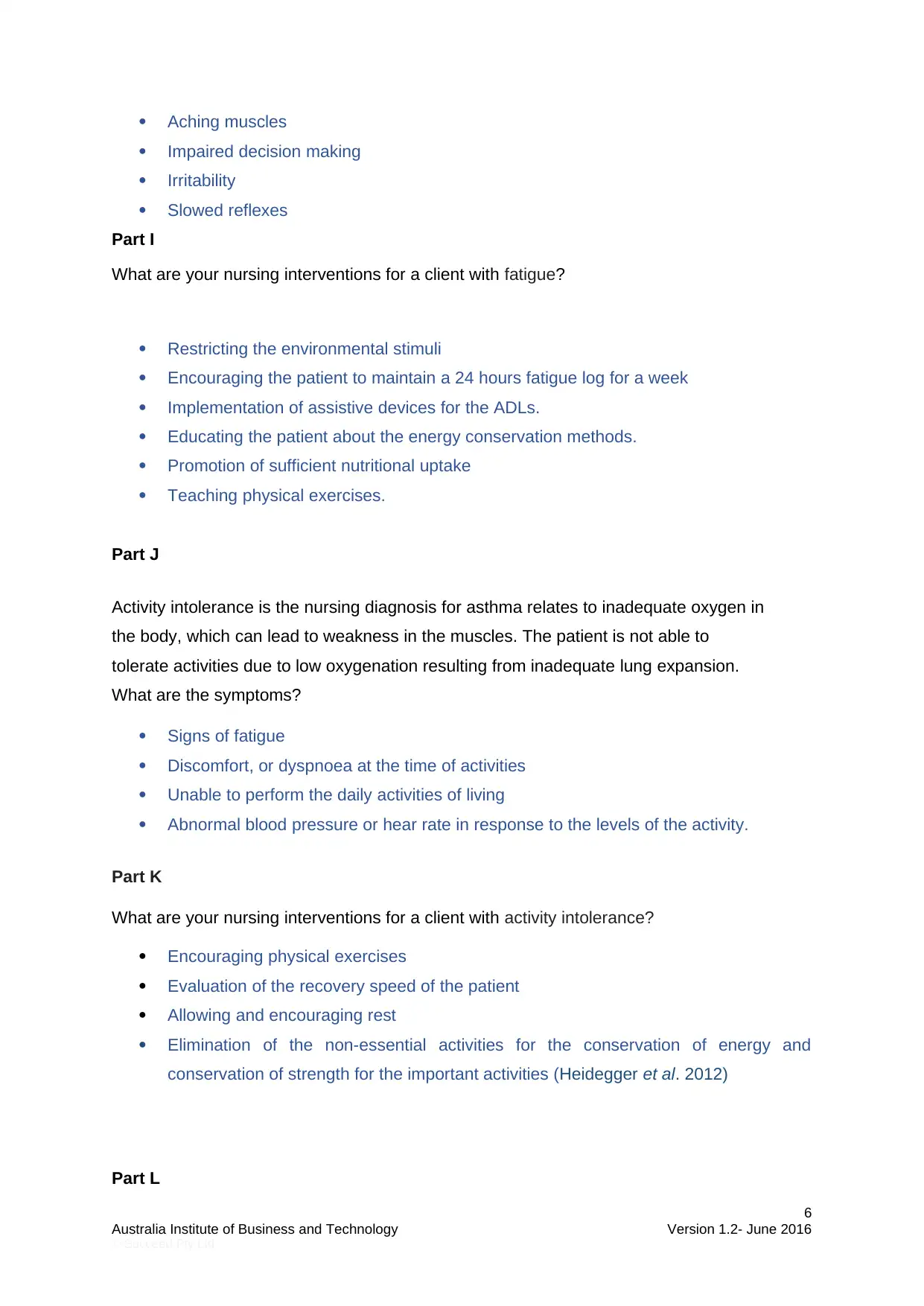
Aching muscles
Impaired decision making
Irritability
Slowed reflexes
Part I
What are your nursing interventions for a client with fatigue?
Restricting the environmental stimuli
Encouraging the patient to maintain a 24 hours fatigue log for a week
Implementation of assistive devices for the ADLs.
Educating the patient about the energy conservation methods.
Promotion of sufficient nutritional uptake
Teaching physical exercises.
Part J
Activity intolerance is the nursing diagnosis for asthma relates to inadequate oxygen in
the body, which can lead to weakness in the muscles. The patient is not able to
tolerate activities due to low oxygenation resulting from inadequate lung expansion.
What are the symptoms?
Signs of fatigue
Discomfort, or dyspnoea at the time of activities
Unable to perform the daily activities of living
Abnormal blood pressure or hear rate in response to the levels of the activity.
Part K
What are your nursing interventions for a client with activity intolerance?
Encouraging physical exercises
Evaluation of the recovery speed of the patient
Allowing and encouraging rest
Elimination of the non-essential activities for the conservation of energy and
conservation of strength for the important activities (Heidegger et al. 2012)
Part L
6
Australia Institute of Business and Technology Version 1.2- June 2016
© Succeed Pty Ltd
Impaired decision making
Irritability
Slowed reflexes
Part I
What are your nursing interventions for a client with fatigue?
Restricting the environmental stimuli
Encouraging the patient to maintain a 24 hours fatigue log for a week
Implementation of assistive devices for the ADLs.
Educating the patient about the energy conservation methods.
Promotion of sufficient nutritional uptake
Teaching physical exercises.
Part J
Activity intolerance is the nursing diagnosis for asthma relates to inadequate oxygen in
the body, which can lead to weakness in the muscles. The patient is not able to
tolerate activities due to low oxygenation resulting from inadequate lung expansion.
What are the symptoms?
Signs of fatigue
Discomfort, or dyspnoea at the time of activities
Unable to perform the daily activities of living
Abnormal blood pressure or hear rate in response to the levels of the activity.
Part K
What are your nursing interventions for a client with activity intolerance?
Encouraging physical exercises
Evaluation of the recovery speed of the patient
Allowing and encouraging rest
Elimination of the non-essential activities for the conservation of energy and
conservation of strength for the important activities (Heidegger et al. 2012)
Part L
6
Australia Institute of Business and Technology Version 1.2- June 2016
© Succeed Pty Ltd
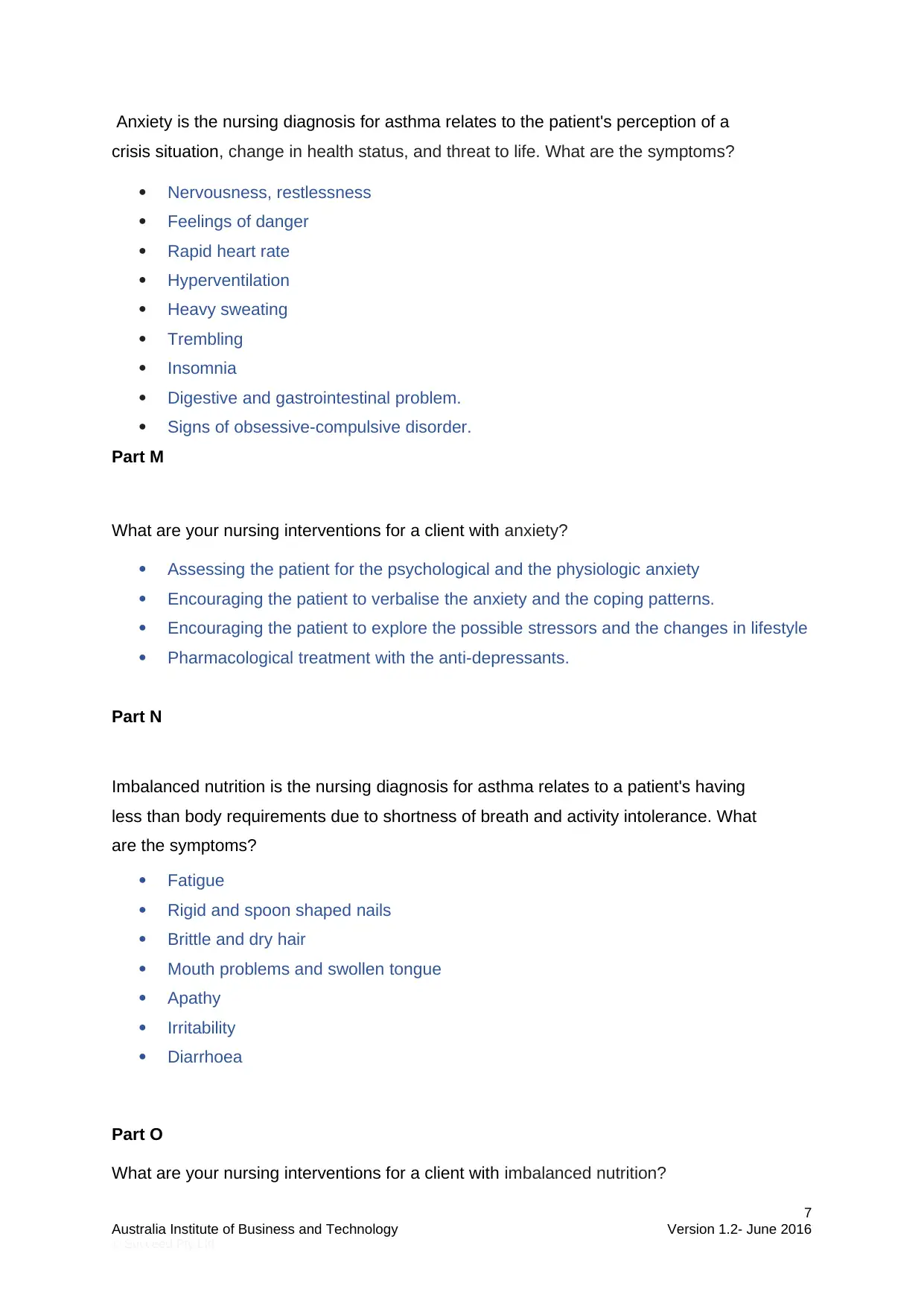
Anxiety is the nursing diagnosis for asthma relates to the patient's perception of a
crisis situation, change in health status, and threat to life. What are the symptoms?
Nervousness, restlessness
Feelings of danger
Rapid heart rate
Hyperventilation
Heavy sweating
Trembling
Insomnia
Digestive and gastrointestinal problem.
Signs of obsessive-compulsive disorder.
Part M
What are your nursing interventions for a client with anxiety?
Assessing the patient for the psychological and the physiologic anxiety
Encouraging the patient to verbalise the anxiety and the coping patterns.
Encouraging the patient to explore the possible stressors and the changes in lifestyle
Pharmacological treatment with the anti-depressants.
Part N
Imbalanced nutrition is the nursing diagnosis for asthma relates to a patient's having
less than body requirements due to shortness of breath and activity intolerance. What
are the symptoms?
Fatigue
Rigid and spoon shaped nails
Brittle and dry hair
Mouth problems and swollen tongue
Apathy
Irritability
Diarrhoea
Part O
What are your nursing interventions for a client with imbalanced nutrition?
7
Australia Institute of Business and Technology Version 1.2- June 2016
© Succeed Pty Ltd
crisis situation, change in health status, and threat to life. What are the symptoms?
Nervousness, restlessness
Feelings of danger
Rapid heart rate
Hyperventilation
Heavy sweating
Trembling
Insomnia
Digestive and gastrointestinal problem.
Signs of obsessive-compulsive disorder.
Part M
What are your nursing interventions for a client with anxiety?
Assessing the patient for the psychological and the physiologic anxiety
Encouraging the patient to verbalise the anxiety and the coping patterns.
Encouraging the patient to explore the possible stressors and the changes in lifestyle
Pharmacological treatment with the anti-depressants.
Part N
Imbalanced nutrition is the nursing diagnosis for asthma relates to a patient's having
less than body requirements due to shortness of breath and activity intolerance. What
are the symptoms?
Fatigue
Rigid and spoon shaped nails
Brittle and dry hair
Mouth problems and swollen tongue
Apathy
Irritability
Diarrhoea
Part O
What are your nursing interventions for a client with imbalanced nutrition?
7
Australia Institute of Business and Technology Version 1.2- June 2016
© Succeed Pty Ltd
Secure Best Marks with AI Grader
Need help grading? Try our AI Grader for instant feedback on your assignments.
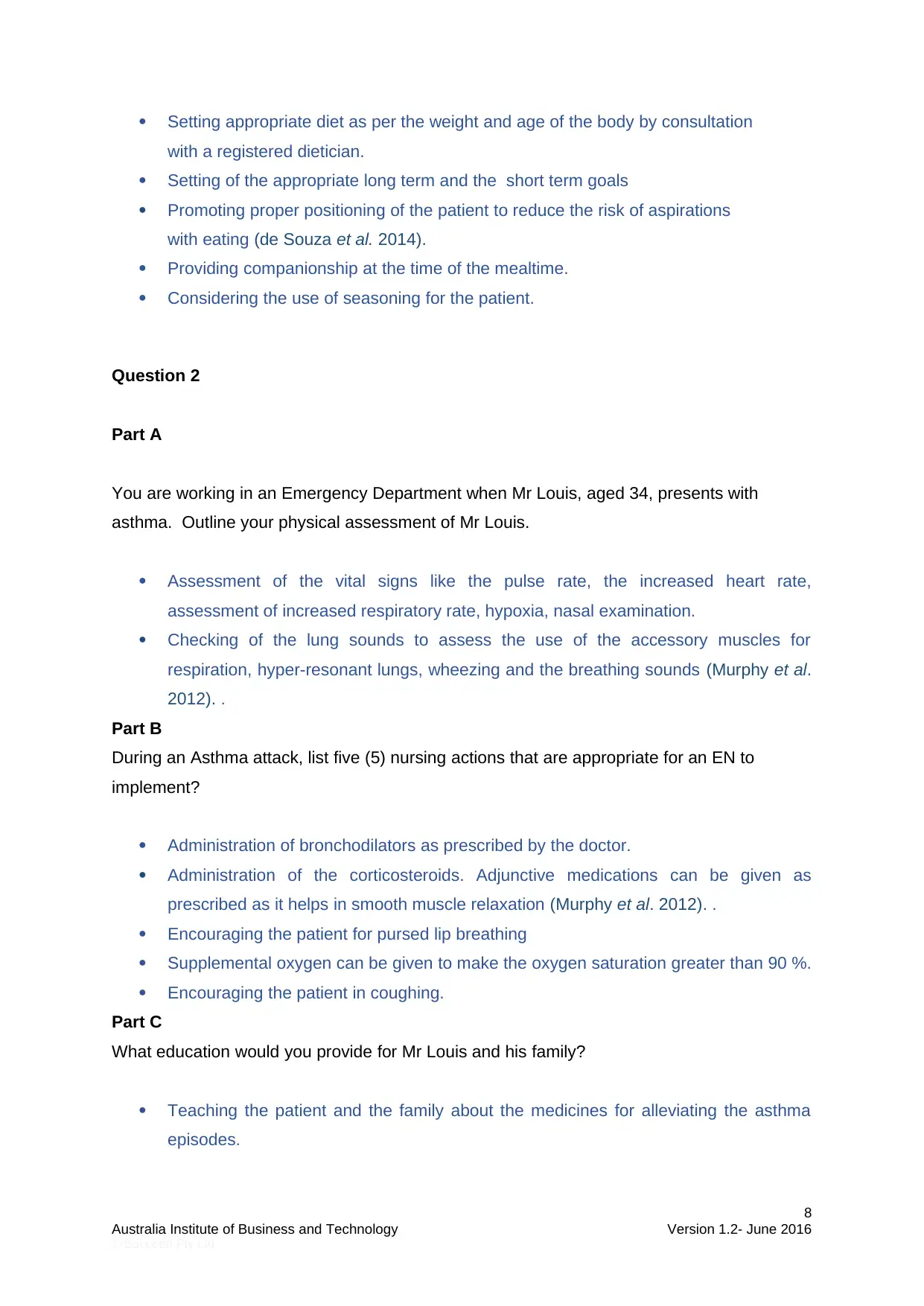
Setting appropriate diet as per the weight and age of the body by consultation
with a registered dietician.
Setting of the appropriate long term and the short term goals
Promoting proper positioning of the patient to reduce the risk of aspirations
with eating (de Souza et al. 2014).
Providing companionship at the time of the mealtime.
Considering the use of seasoning for the patient.
Question 2
Part A
You are working in an Emergency Department when Mr Louis, aged 34, presents with
asthma. Outline your physical assessment of Mr Louis.
Assessment of the vital signs like the pulse rate, the increased heart rate,
assessment of increased respiratory rate, hypoxia, nasal examination.
Checking of the lung sounds to assess the use of the accessory muscles for
respiration, hyper-resonant lungs, wheezing and the breathing sounds (Murphy et al.
2012). .
Part B
During an Asthma attack, list five (5) nursing actions that are appropriate for an EN to
implement?
Administration of bronchodilators as prescribed by the doctor.
Administration of the corticosteroids. Adjunctive medications can be given as
prescribed as it helps in smooth muscle relaxation (Murphy et al. 2012). .
Encouraging the patient for pursed lip breathing
Supplemental oxygen can be given to make the oxygen saturation greater than 90 %.
Encouraging the patient in coughing.
Part C
What education would you provide for Mr Louis and his family?
Teaching the patient and the family about the medicines for alleviating the asthma
episodes.
8
Australia Institute of Business and Technology Version 1.2- June 2016
© Succeed Pty Ltd
with a registered dietician.
Setting of the appropriate long term and the short term goals
Promoting proper positioning of the patient to reduce the risk of aspirations
with eating (de Souza et al. 2014).
Providing companionship at the time of the mealtime.
Considering the use of seasoning for the patient.
Question 2
Part A
You are working in an Emergency Department when Mr Louis, aged 34, presents with
asthma. Outline your physical assessment of Mr Louis.
Assessment of the vital signs like the pulse rate, the increased heart rate,
assessment of increased respiratory rate, hypoxia, nasal examination.
Checking of the lung sounds to assess the use of the accessory muscles for
respiration, hyper-resonant lungs, wheezing and the breathing sounds (Murphy et al.
2012). .
Part B
During an Asthma attack, list five (5) nursing actions that are appropriate for an EN to
implement?
Administration of bronchodilators as prescribed by the doctor.
Administration of the corticosteroids. Adjunctive medications can be given as
prescribed as it helps in smooth muscle relaxation (Murphy et al. 2012). .
Encouraging the patient for pursed lip breathing
Supplemental oxygen can be given to make the oxygen saturation greater than 90 %.
Encouraging the patient in coughing.
Part C
What education would you provide for Mr Louis and his family?
Teaching the patient and the family about the medicines for alleviating the asthma
episodes.
8
Australia Institute of Business and Technology Version 1.2- June 2016
© Succeed Pty Ltd
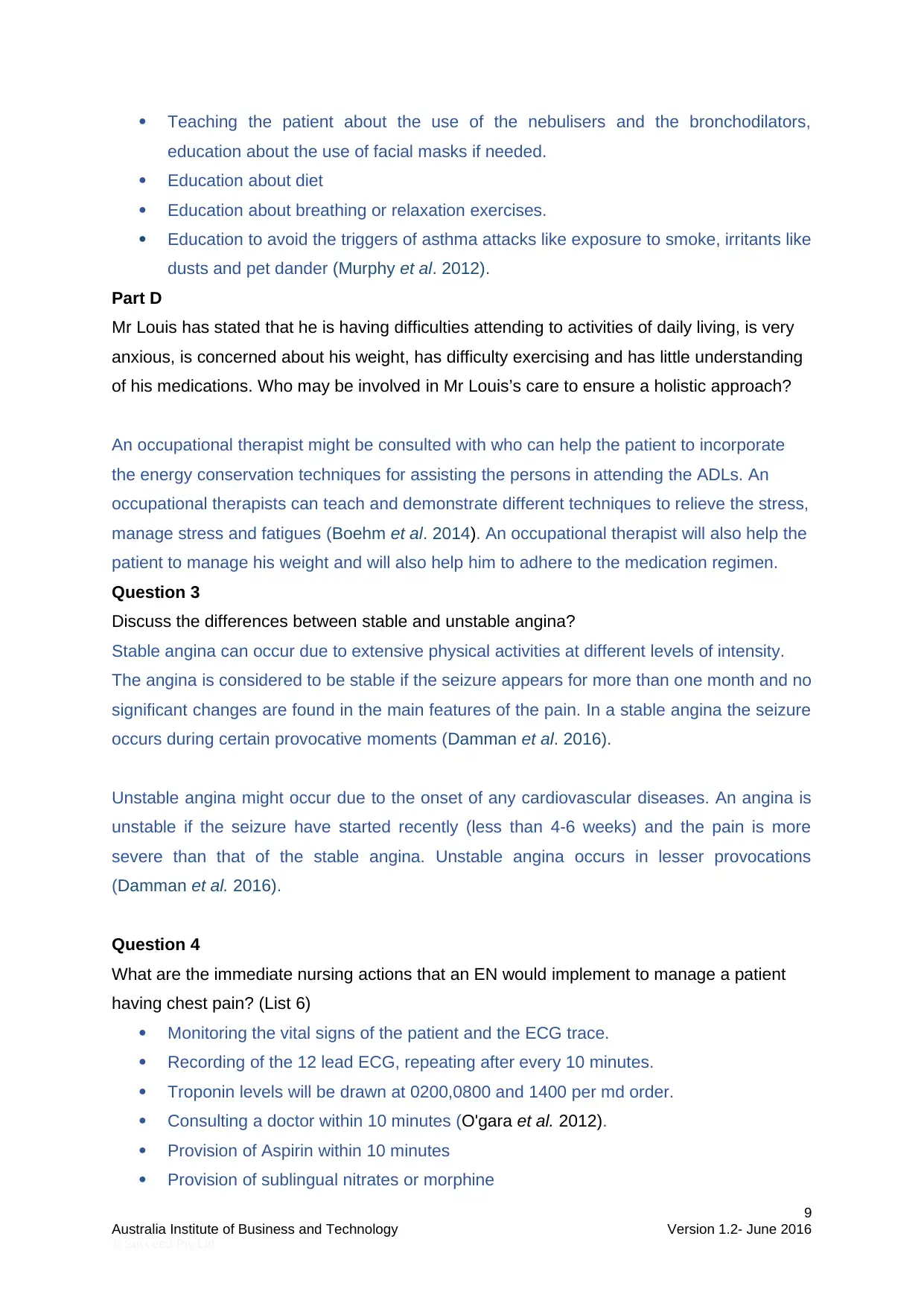
Teaching the patient about the use of the nebulisers and the bronchodilators,
education about the use of facial masks if needed.
Education about diet
Education about breathing or relaxation exercises.
Education to avoid the triggers of asthma attacks like exposure to smoke, irritants like
dusts and pet dander (Murphy et al. 2012).
Part D
Mr Louis has stated that he is having difficulties attending to activities of daily living, is very
anxious, is concerned about his weight, has difficulty exercising and has little understanding
of his medications. Who may be involved in Mr Louis’s care to ensure a holistic approach?
An occupational therapist might be consulted with who can help the patient to incorporate
the energy conservation techniques for assisting the persons in attending the ADLs. An
occupational therapists can teach and demonstrate different techniques to relieve the stress,
manage stress and fatigues (Boehm et al. 2014). An occupational therapist will also help the
patient to manage his weight and will also help him to adhere to the medication regimen.
Question 3
Discuss the differences between stable and unstable angina?
Stable angina can occur due to extensive physical activities at different levels of intensity.
The angina is considered to be stable if the seizure appears for more than one month and no
significant changes are found in the main features of the pain. In a stable angina the seizure
occurs during certain provocative moments (Damman et al. 2016).
Unstable angina might occur due to the onset of any cardiovascular diseases. An angina is
unstable if the seizure have started recently (less than 4-6 weeks) and the pain is more
severe than that of the stable angina. Unstable angina occurs in lesser provocations
(Damman et al. 2016).
Question 4
What are the immediate nursing actions that an EN would implement to manage a patient
having chest pain? (List 6)
Monitoring the vital signs of the patient and the ECG trace.
Recording of the 12 lead ECG, repeating after every 10 minutes.
Troponin levels will be drawn at 0200,0800 and 1400 per md order.
Consulting a doctor within 10 minutes (O'gara et al. 2012).
Provision of Aspirin within 10 minutes
Provision of sublingual nitrates or morphine
9
Australia Institute of Business and Technology Version 1.2- June 2016
© Succeed Pty Ltd
education about the use of facial masks if needed.
Education about diet
Education about breathing or relaxation exercises.
Education to avoid the triggers of asthma attacks like exposure to smoke, irritants like
dusts and pet dander (Murphy et al. 2012).
Part D
Mr Louis has stated that he is having difficulties attending to activities of daily living, is very
anxious, is concerned about his weight, has difficulty exercising and has little understanding
of his medications. Who may be involved in Mr Louis’s care to ensure a holistic approach?
An occupational therapist might be consulted with who can help the patient to incorporate
the energy conservation techniques for assisting the persons in attending the ADLs. An
occupational therapists can teach and demonstrate different techniques to relieve the stress,
manage stress and fatigues (Boehm et al. 2014). An occupational therapist will also help the
patient to manage his weight and will also help him to adhere to the medication regimen.
Question 3
Discuss the differences between stable and unstable angina?
Stable angina can occur due to extensive physical activities at different levels of intensity.
The angina is considered to be stable if the seizure appears for more than one month and no
significant changes are found in the main features of the pain. In a stable angina the seizure
occurs during certain provocative moments (Damman et al. 2016).
Unstable angina might occur due to the onset of any cardiovascular diseases. An angina is
unstable if the seizure have started recently (less than 4-6 weeks) and the pain is more
severe than that of the stable angina. Unstable angina occurs in lesser provocations
(Damman et al. 2016).
Question 4
What are the immediate nursing actions that an EN would implement to manage a patient
having chest pain? (List 6)
Monitoring the vital signs of the patient and the ECG trace.
Recording of the 12 lead ECG, repeating after every 10 minutes.
Troponin levels will be drawn at 0200,0800 and 1400 per md order.
Consulting a doctor within 10 minutes (O'gara et al. 2012).
Provision of Aspirin within 10 minutes
Provision of sublingual nitrates or morphine
9
Australia Institute of Business and Technology Version 1.2- June 2016
© Succeed Pty Ltd
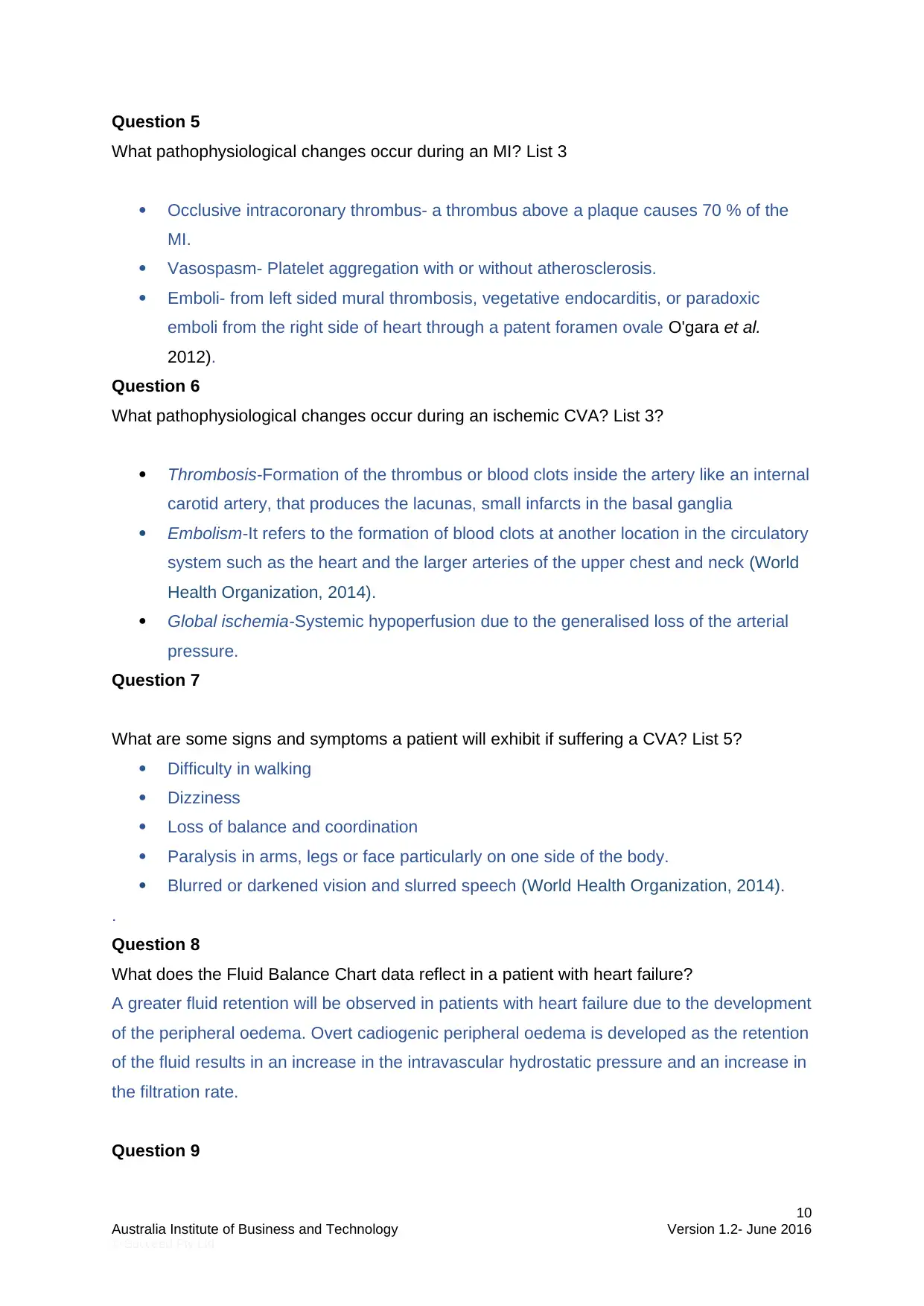
Question 5
What pathophysiological changes occur during an MI? List 3
Occlusive intracoronary thrombus- a thrombus above a plaque causes 70 % of the
MI.
Vasospasm- Platelet aggregation with or without atherosclerosis.
Emboli- from left sided mural thrombosis, vegetative endocarditis, or paradoxic
emboli from the right side of heart through a patent foramen ovale O'gara et al.
2012).
Question 6
What pathophysiological changes occur during an ischemic CVA? List 3?
Thrombosis-Formation of the thrombus or blood clots inside the artery like an internal
carotid artery, that produces the lacunas, small infarcts in the basal ganglia
Embolism-It refers to the formation of blood clots at another location in the circulatory
system such as the heart and the larger arteries of the upper chest and neck (World
Health Organization, 2014).
Global ischemia-Systemic hypoperfusion due to the generalised loss of the arterial
pressure.
Question 7
What are some signs and symptoms a patient will exhibit if suffering a CVA? List 5?
Difficulty in walking
Dizziness
Loss of balance and coordination
Paralysis in arms, legs or face particularly on one side of the body.
Blurred or darkened vision and slurred speech (World Health Organization, 2014).
.
Question 8
What does the Fluid Balance Chart data reflect in a patient with heart failure?
A greater fluid retention will be observed in patients with heart failure due to the development
of the peripheral oedema. Overt cadiogenic peripheral oedema is developed as the retention
of the fluid results in an increase in the intravascular hydrostatic pressure and an increase in
the filtration rate.
Question 9
10
Australia Institute of Business and Technology Version 1.2- June 2016
© Succeed Pty Ltd
What pathophysiological changes occur during an MI? List 3
Occlusive intracoronary thrombus- a thrombus above a plaque causes 70 % of the
MI.
Vasospasm- Platelet aggregation with or without atherosclerosis.
Emboli- from left sided mural thrombosis, vegetative endocarditis, or paradoxic
emboli from the right side of heart through a patent foramen ovale O'gara et al.
2012).
Question 6
What pathophysiological changes occur during an ischemic CVA? List 3?
Thrombosis-Formation of the thrombus or blood clots inside the artery like an internal
carotid artery, that produces the lacunas, small infarcts in the basal ganglia
Embolism-It refers to the formation of blood clots at another location in the circulatory
system such as the heart and the larger arteries of the upper chest and neck (World
Health Organization, 2014).
Global ischemia-Systemic hypoperfusion due to the generalised loss of the arterial
pressure.
Question 7
What are some signs and symptoms a patient will exhibit if suffering a CVA? List 5?
Difficulty in walking
Dizziness
Loss of balance and coordination
Paralysis in arms, legs or face particularly on one side of the body.
Blurred or darkened vision and slurred speech (World Health Organization, 2014).
.
Question 8
What does the Fluid Balance Chart data reflect in a patient with heart failure?
A greater fluid retention will be observed in patients with heart failure due to the development
of the peripheral oedema. Overt cadiogenic peripheral oedema is developed as the retention
of the fluid results in an increase in the intravascular hydrostatic pressure and an increase in
the filtration rate.
Question 9
10
Australia Institute of Business and Technology Version 1.2- June 2016
© Succeed Pty Ltd
Paraphrase This Document
Need a fresh take? Get an instant paraphrase of this document with our AI Paraphraser
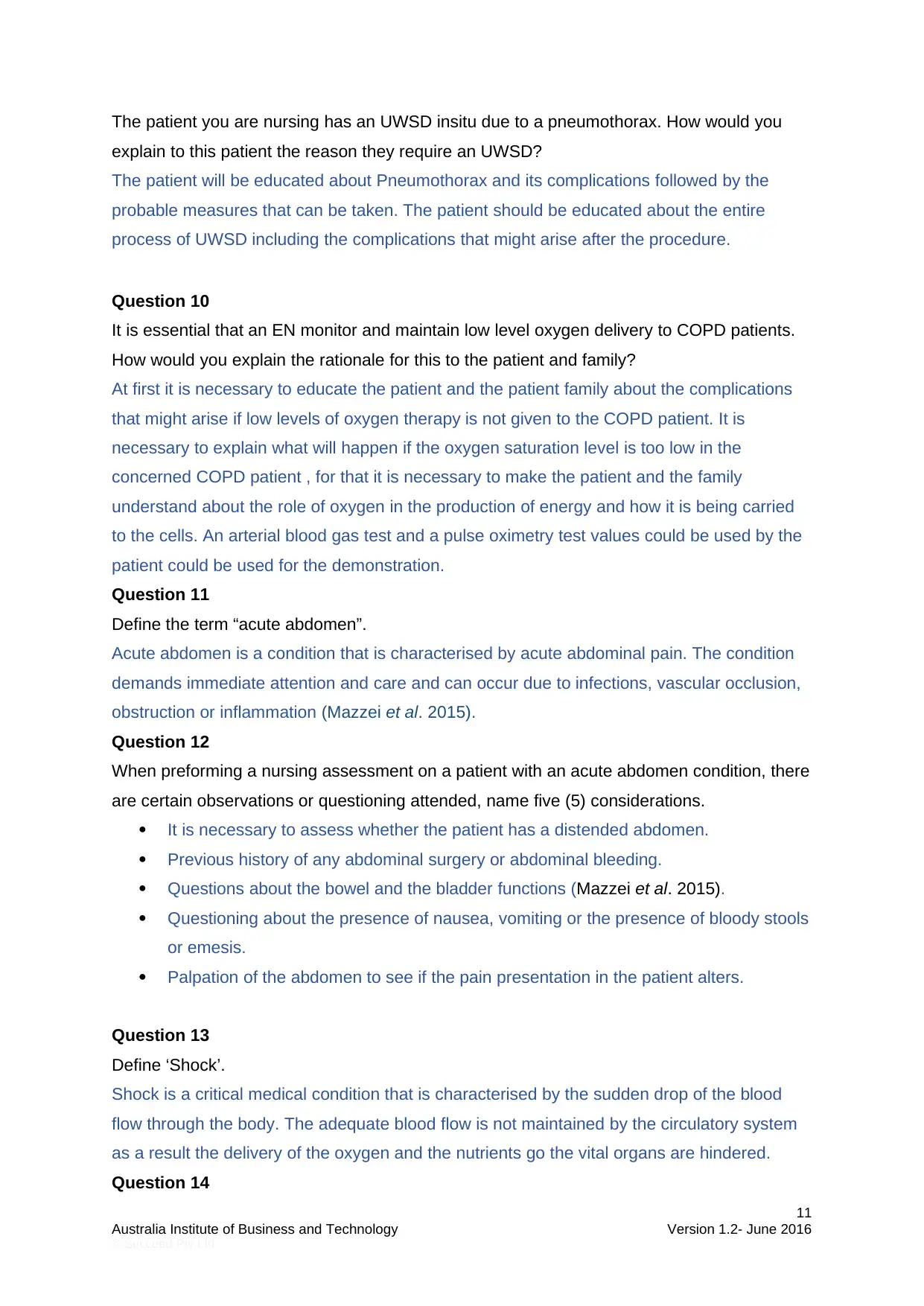
The patient you are nursing has an UWSD insitu due to a pneumothorax. How would you
explain to this patient the reason they require an UWSD?
The patient will be educated about Pneumothorax and its complications followed by the
probable measures that can be taken. The patient should be educated about the entire
process of UWSD including the complications that might arise after the procedure.
Question 10
It is essential that an EN monitor and maintain low level oxygen delivery to COPD patients.
How would you explain the rationale for this to the patient and family?
At first it is necessary to educate the patient and the patient family about the complications
that might arise if low levels of oxygen therapy is not given to the COPD patient. It is
necessary to explain what will happen if the oxygen saturation level is too low in the
concerned COPD patient , for that it is necessary to make the patient and the family
understand about the role of oxygen in the production of energy and how it is being carried
to the cells. An arterial blood gas test and a pulse oximetry test values could be used by the
patient could be used for the demonstration.
Question 11
Define the term “acute abdomen”.
Acute abdomen is a condition that is characterised by acute abdominal pain. The condition
demands immediate attention and care and can occur due to infections, vascular occlusion,
obstruction or inflammation (Mazzei et al. 2015).
Question 12
When preforming a nursing assessment on a patient with an acute abdomen condition, there
are certain observations or questioning attended, name five (5) considerations.
It is necessary to assess whether the patient has a distended abdomen.
Previous history of any abdominal surgery or abdominal bleeding.
Questions about the bowel and the bladder functions (Mazzei et al. 2015).
Questioning about the presence of nausea, vomiting or the presence of bloody stools
or emesis.
Palpation of the abdomen to see if the pain presentation in the patient alters.
Question 13
Define ‘Shock’.
Shock is a critical medical condition that is characterised by the sudden drop of the blood
flow through the body. The adequate blood flow is not maintained by the circulatory system
as a result the delivery of the oxygen and the nutrients go the vital organs are hindered.
Question 14
11
Australia Institute of Business and Technology Version 1.2- June 2016
© Succeed Pty Ltd
explain to this patient the reason they require an UWSD?
The patient will be educated about Pneumothorax and its complications followed by the
probable measures that can be taken. The patient should be educated about the entire
process of UWSD including the complications that might arise after the procedure.
Question 10
It is essential that an EN monitor and maintain low level oxygen delivery to COPD patients.
How would you explain the rationale for this to the patient and family?
At first it is necessary to educate the patient and the patient family about the complications
that might arise if low levels of oxygen therapy is not given to the COPD patient. It is
necessary to explain what will happen if the oxygen saturation level is too low in the
concerned COPD patient , for that it is necessary to make the patient and the family
understand about the role of oxygen in the production of energy and how it is being carried
to the cells. An arterial blood gas test and a pulse oximetry test values could be used by the
patient could be used for the demonstration.
Question 11
Define the term “acute abdomen”.
Acute abdomen is a condition that is characterised by acute abdominal pain. The condition
demands immediate attention and care and can occur due to infections, vascular occlusion,
obstruction or inflammation (Mazzei et al. 2015).
Question 12
When preforming a nursing assessment on a patient with an acute abdomen condition, there
are certain observations or questioning attended, name five (5) considerations.
It is necessary to assess whether the patient has a distended abdomen.
Previous history of any abdominal surgery or abdominal bleeding.
Questions about the bowel and the bladder functions (Mazzei et al. 2015).
Questioning about the presence of nausea, vomiting or the presence of bloody stools
or emesis.
Palpation of the abdomen to see if the pain presentation in the patient alters.
Question 13
Define ‘Shock’.
Shock is a critical medical condition that is characterised by the sudden drop of the blood
flow through the body. The adequate blood flow is not maintained by the circulatory system
as a result the delivery of the oxygen and the nutrients go the vital organs are hindered.
Question 14
11
Australia Institute of Business and Technology Version 1.2- June 2016
© Succeed Pty Ltd
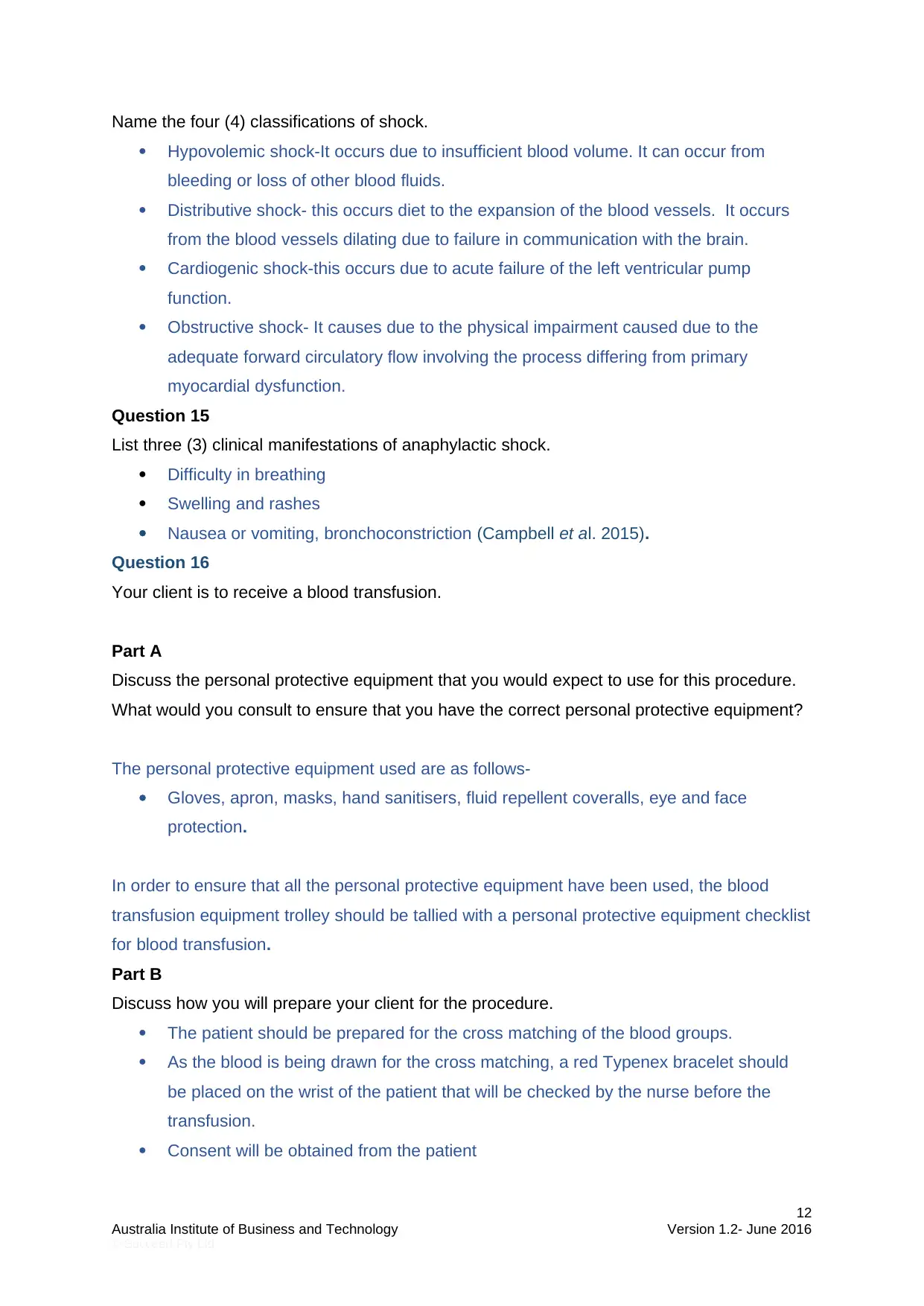
Name the four (4) classifications of shock.
Hypovolemic shock-It occurs due to insufficient blood volume. It can occur from
bleeding or loss of other blood fluids.
Distributive shock- this occurs diet to the expansion of the blood vessels. It occurs
from the blood vessels dilating due to failure in communication with the brain.
Cardiogenic shock-this occurs due to acute failure of the left ventricular pump
function.
Obstructive shock- It causes due to the physical impairment caused due to the
adequate forward circulatory flow involving the process differing from primary
myocardial dysfunction.
Question 15
List three (3) clinical manifestations of anaphylactic shock.
Difficulty in breathing
Swelling and rashes
Nausea or vomiting, bronchoconstriction (Campbell et al. 2015).
Question 16
Your client is to receive a blood transfusion.
Part A
Discuss the personal protective equipment that you would expect to use for this procedure.
What would you consult to ensure that you have the correct personal protective equipment?
The personal protective equipment used are as follows-
Gloves, apron, masks, hand sanitisers, fluid repellent coveralls, eye and face
protection.
In order to ensure that all the personal protective equipment have been used, the blood
transfusion equipment trolley should be tallied with a personal protective equipment checklist
for blood transfusion.
Part B
Discuss how you will prepare your client for the procedure.
The patient should be prepared for the cross matching of the blood groups.
As the blood is being drawn for the cross matching, a red Typenex bracelet should
be placed on the wrist of the patient that will be checked by the nurse before the
transfusion.
Consent will be obtained from the patient
12
Australia Institute of Business and Technology Version 1.2- June 2016
© Succeed Pty Ltd
Hypovolemic shock-It occurs due to insufficient blood volume. It can occur from
bleeding or loss of other blood fluids.
Distributive shock- this occurs diet to the expansion of the blood vessels. It occurs
from the blood vessels dilating due to failure in communication with the brain.
Cardiogenic shock-this occurs due to acute failure of the left ventricular pump
function.
Obstructive shock- It causes due to the physical impairment caused due to the
adequate forward circulatory flow involving the process differing from primary
myocardial dysfunction.
Question 15
List three (3) clinical manifestations of anaphylactic shock.
Difficulty in breathing
Swelling and rashes
Nausea or vomiting, bronchoconstriction (Campbell et al. 2015).
Question 16
Your client is to receive a blood transfusion.
Part A
Discuss the personal protective equipment that you would expect to use for this procedure.
What would you consult to ensure that you have the correct personal protective equipment?
The personal protective equipment used are as follows-
Gloves, apron, masks, hand sanitisers, fluid repellent coveralls, eye and face
protection.
In order to ensure that all the personal protective equipment have been used, the blood
transfusion equipment trolley should be tallied with a personal protective equipment checklist
for blood transfusion.
Part B
Discuss how you will prepare your client for the procedure.
The patient should be prepared for the cross matching of the blood groups.
As the blood is being drawn for the cross matching, a red Typenex bracelet should
be placed on the wrist of the patient that will be checked by the nurse before the
transfusion.
Consent will be obtained from the patient
12
Australia Institute of Business and Technology Version 1.2- June 2016
© Succeed Pty Ltd

The vital signs should be taken before, during and after the transfusion. If the patient
had any past history of transfusion reactions, then medications will be given 30
minutes prior to the procedure.
Part C
Discuss the pre-transfusion checks that are usually required in a health facility.
The pre-transfusion tests includes the ABO and the Rh (D) typing of the red blood cells of
the recipients. The ABO typing involves the testing of the recipient’s red blood cells for the
presence of the A and the B antigens using the Anti- A and the anti-B antisera. The Rh-
typing is determined by the testing of the red blood cells of the recipients with an anti- D.
Antibody screening is necessary to detect the presence of antibodies to non-group A or the b
antigens. Alloantibodies to the antigens that are not present in the blood cells of an individual
might develop who had been exposed to foreign red blood cells due to a previous blood
transfusion and pregnancy. Cross-matching is done to confirm the compatibility between the
patient and the donor’s blood.
Part D
Discuss the usual observations, and frequency, required for an adult receiving a blood
transfusion.
The blood transfusion will be given in an outpatient clinic. Before the procedure the
nurses will confirm that the blood has been tested and has been prepared for the
person.
The ABO and the Rh compatibility, the identity, the hospital ID number, the number
of the Typenex bracelet should be verified.
The vital signs like the respiration, pulse and the temperature shall be monitored
before and after the transfusion.
The patient can eat or drink during the transfusion or can also move around.
Some of the patients might have transfusion reaction and hence should be monitored
for symptoms like hives, chest pain, headache or heat where the transfusion has
been made.
Part E
Each blood product transfused carries a small risk of an adverse effect. Name three
adverse effects.
Fevers and chills
Back pain and flank pain
13
Australia Institute of Business and Technology Version 1.2- June 2016
© Succeed Pty Ltd
had any past history of transfusion reactions, then medications will be given 30
minutes prior to the procedure.
Part C
Discuss the pre-transfusion checks that are usually required in a health facility.
The pre-transfusion tests includes the ABO and the Rh (D) typing of the red blood cells of
the recipients. The ABO typing involves the testing of the recipient’s red blood cells for the
presence of the A and the B antigens using the Anti- A and the anti-B antisera. The Rh-
typing is determined by the testing of the red blood cells of the recipients with an anti- D.
Antibody screening is necessary to detect the presence of antibodies to non-group A or the b
antigens. Alloantibodies to the antigens that are not present in the blood cells of an individual
might develop who had been exposed to foreign red blood cells due to a previous blood
transfusion and pregnancy. Cross-matching is done to confirm the compatibility between the
patient and the donor’s blood.
Part D
Discuss the usual observations, and frequency, required for an adult receiving a blood
transfusion.
The blood transfusion will be given in an outpatient clinic. Before the procedure the
nurses will confirm that the blood has been tested and has been prepared for the
person.
The ABO and the Rh compatibility, the identity, the hospital ID number, the number
of the Typenex bracelet should be verified.
The vital signs like the respiration, pulse and the temperature shall be monitored
before and after the transfusion.
The patient can eat or drink during the transfusion or can also move around.
Some of the patients might have transfusion reaction and hence should be monitored
for symptoms like hives, chest pain, headache or heat where the transfusion has
been made.
Part E
Each blood product transfused carries a small risk of an adverse effect. Name three
adverse effects.
Fevers and chills
Back pain and flank pain
13
Australia Institute of Business and Technology Version 1.2- June 2016
© Succeed Pty Ltd
Secure Best Marks with AI Grader
Need help grading? Try our AI Grader for instant feedback on your assignments.
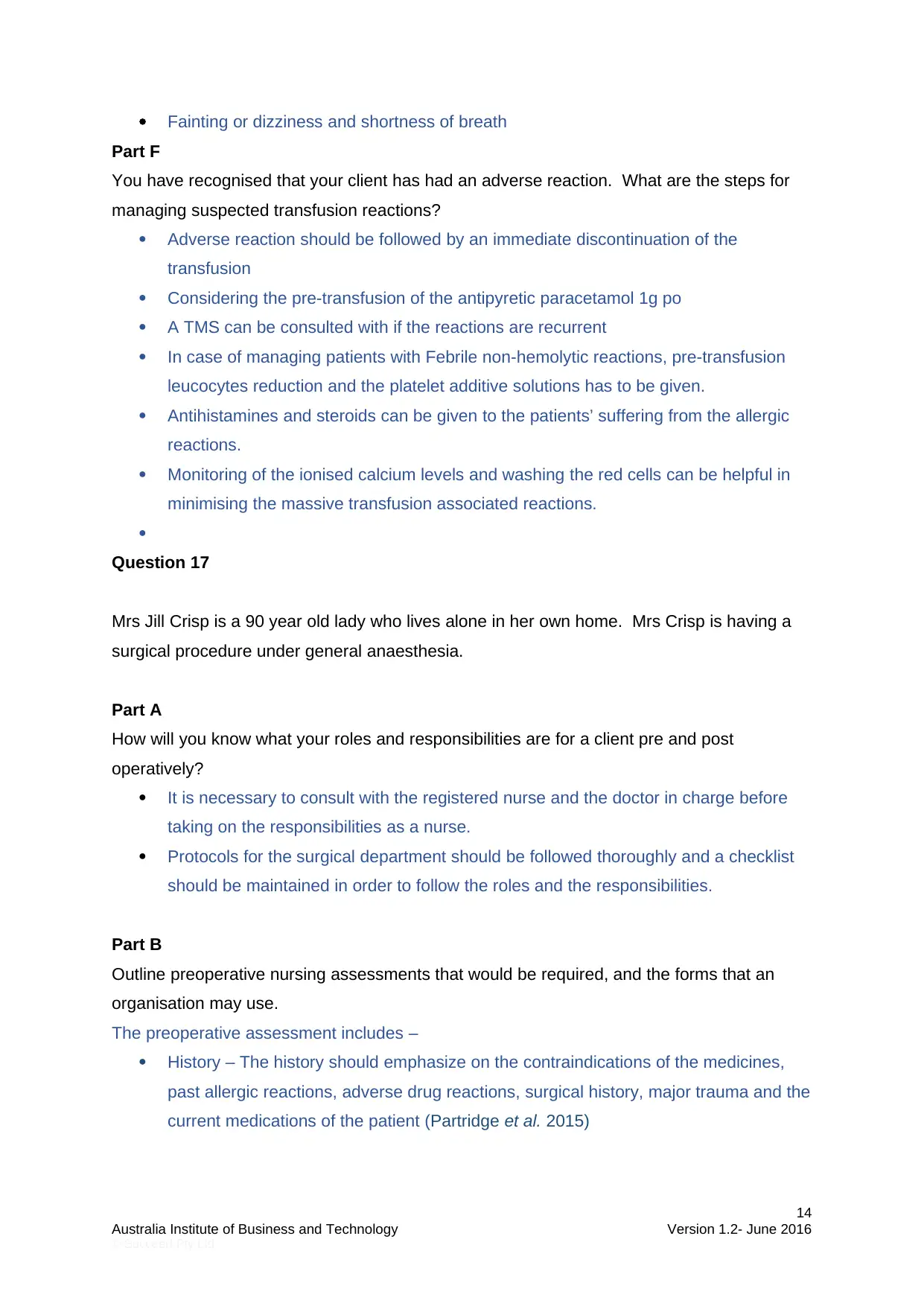
Fainting or dizziness and shortness of breath
Part F
You have recognised that your client has had an adverse reaction. What are the steps for
managing suspected transfusion reactions?
Adverse reaction should be followed by an immediate discontinuation of the
transfusion
Considering the pre-transfusion of the antipyretic paracetamol 1g po
A TMS can be consulted with if the reactions are recurrent
In case of managing patients with Febrile non-hemolytic reactions, pre-transfusion
leucocytes reduction and the platelet additive solutions has to be given.
Antihistamines and steroids can be given to the patients’ suffering from the allergic
reactions.
Monitoring of the ionised calcium levels and washing the red cells can be helpful in
minimising the massive transfusion associated reactions.
Question 17
Mrs Jill Crisp is a 90 year old lady who lives alone in her own home. Mrs Crisp is having a
surgical procedure under general anaesthesia.
Part A
How will you know what your roles and responsibilities are for a client pre and post
operatively?
It is necessary to consult with the registered nurse and the doctor in charge before
taking on the responsibilities as a nurse.
Protocols for the surgical department should be followed thoroughly and a checklist
should be maintained in order to follow the roles and the responsibilities.
Part B
Outline preoperative nursing assessments that would be required, and the forms that an
organisation may use.
The preoperative assessment includes –
History – The history should emphasize on the contraindications of the medicines,
past allergic reactions, adverse drug reactions, surgical history, major trauma and the
current medications of the patient (Partridge et al. 2015)
14
Australia Institute of Business and Technology Version 1.2- June 2016
© Succeed Pty Ltd
Part F
You have recognised that your client has had an adverse reaction. What are the steps for
managing suspected transfusion reactions?
Adverse reaction should be followed by an immediate discontinuation of the
transfusion
Considering the pre-transfusion of the antipyretic paracetamol 1g po
A TMS can be consulted with if the reactions are recurrent
In case of managing patients with Febrile non-hemolytic reactions, pre-transfusion
leucocytes reduction and the platelet additive solutions has to be given.
Antihistamines and steroids can be given to the patients’ suffering from the allergic
reactions.
Monitoring of the ionised calcium levels and washing the red cells can be helpful in
minimising the massive transfusion associated reactions.
Question 17
Mrs Jill Crisp is a 90 year old lady who lives alone in her own home. Mrs Crisp is having a
surgical procedure under general anaesthesia.
Part A
How will you know what your roles and responsibilities are for a client pre and post
operatively?
It is necessary to consult with the registered nurse and the doctor in charge before
taking on the responsibilities as a nurse.
Protocols for the surgical department should be followed thoroughly and a checklist
should be maintained in order to follow the roles and the responsibilities.
Part B
Outline preoperative nursing assessments that would be required, and the forms that an
organisation may use.
The preoperative assessment includes –
History – The history should emphasize on the contraindications of the medicines,
past allergic reactions, adverse drug reactions, surgical history, major trauma and the
current medications of the patient (Partridge et al. 2015)
14
Australia Institute of Business and Technology Version 1.2- June 2016
© Succeed Pty Ltd
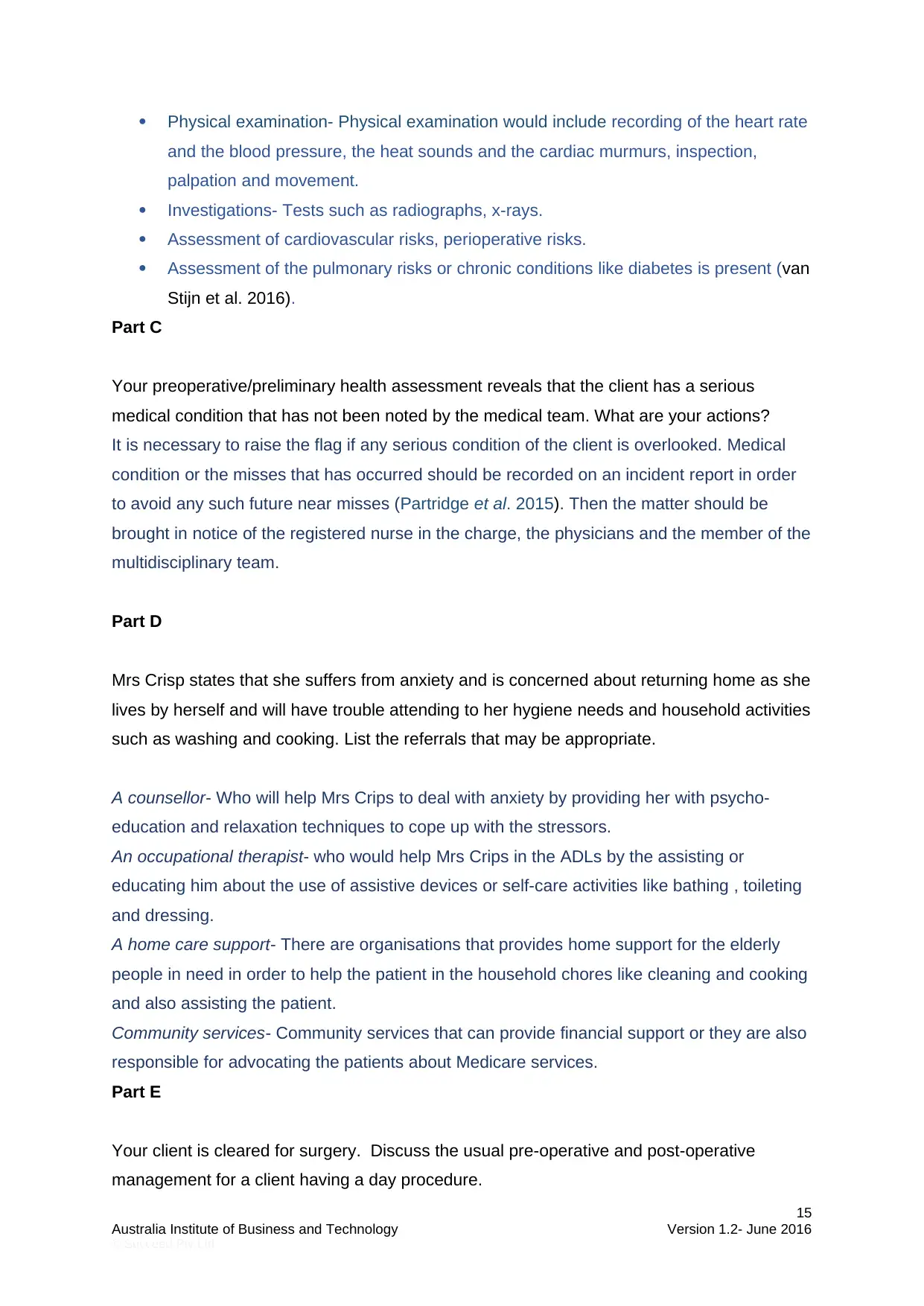
Physical examination- Physical examination would include recording of the heart rate
and the blood pressure, the heat sounds and the cardiac murmurs, inspection,
palpation and movement.
Investigations- Tests such as radiographs, x-rays.
Assessment of cardiovascular risks, perioperative risks.
Assessment of the pulmonary risks or chronic conditions like diabetes is present (van
Stijn et al. 2016).
Part C
Your preoperative/preliminary health assessment reveals that the client has a serious
medical condition that has not been noted by the medical team. What are your actions?
It is necessary to raise the flag if any serious condition of the client is overlooked. Medical
condition or the misses that has occurred should be recorded on an incident report in order
to avoid any such future near misses (Partridge et al. 2015). Then the matter should be
brought in notice of the registered nurse in the charge, the physicians and the member of the
multidisciplinary team.
Part D
Mrs Crisp states that she suffers from anxiety and is concerned about returning home as she
lives by herself and will have trouble attending to her hygiene needs and household activities
such as washing and cooking. List the referrals that may be appropriate.
A counsellor- Who will help Mrs Crips to deal with anxiety by providing her with psycho-
education and relaxation techniques to cope up with the stressors.
An occupational therapist- who would help Mrs Crips in the ADLs by the assisting or
educating him about the use of assistive devices or self-care activities like bathing , toileting
and dressing.
A home care support- There are organisations that provides home support for the elderly
people in need in order to help the patient in the household chores like cleaning and cooking
and also assisting the patient.
Community services- Community services that can provide financial support or they are also
responsible for advocating the patients about Medicare services.
Part E
Your client is cleared for surgery. Discuss the usual pre-operative and post-operative
management for a client having a day procedure.
15
Australia Institute of Business and Technology Version 1.2- June 2016
© Succeed Pty Ltd
and the blood pressure, the heat sounds and the cardiac murmurs, inspection,
palpation and movement.
Investigations- Tests such as radiographs, x-rays.
Assessment of cardiovascular risks, perioperative risks.
Assessment of the pulmonary risks or chronic conditions like diabetes is present (van
Stijn et al. 2016).
Part C
Your preoperative/preliminary health assessment reveals that the client has a serious
medical condition that has not been noted by the medical team. What are your actions?
It is necessary to raise the flag if any serious condition of the client is overlooked. Medical
condition or the misses that has occurred should be recorded on an incident report in order
to avoid any such future near misses (Partridge et al. 2015). Then the matter should be
brought in notice of the registered nurse in the charge, the physicians and the member of the
multidisciplinary team.
Part D
Mrs Crisp states that she suffers from anxiety and is concerned about returning home as she
lives by herself and will have trouble attending to her hygiene needs and household activities
such as washing and cooking. List the referrals that may be appropriate.
A counsellor- Who will help Mrs Crips to deal with anxiety by providing her with psycho-
education and relaxation techniques to cope up with the stressors.
An occupational therapist- who would help Mrs Crips in the ADLs by the assisting or
educating him about the use of assistive devices or self-care activities like bathing , toileting
and dressing.
A home care support- There are organisations that provides home support for the elderly
people in need in order to help the patient in the household chores like cleaning and cooking
and also assisting the patient.
Community services- Community services that can provide financial support or they are also
responsible for advocating the patients about Medicare services.
Part E
Your client is cleared for surgery. Discuss the usual pre-operative and post-operative
management for a client having a day procedure.
15
Australia Institute of Business and Technology Version 1.2- June 2016
© Succeed Pty Ltd
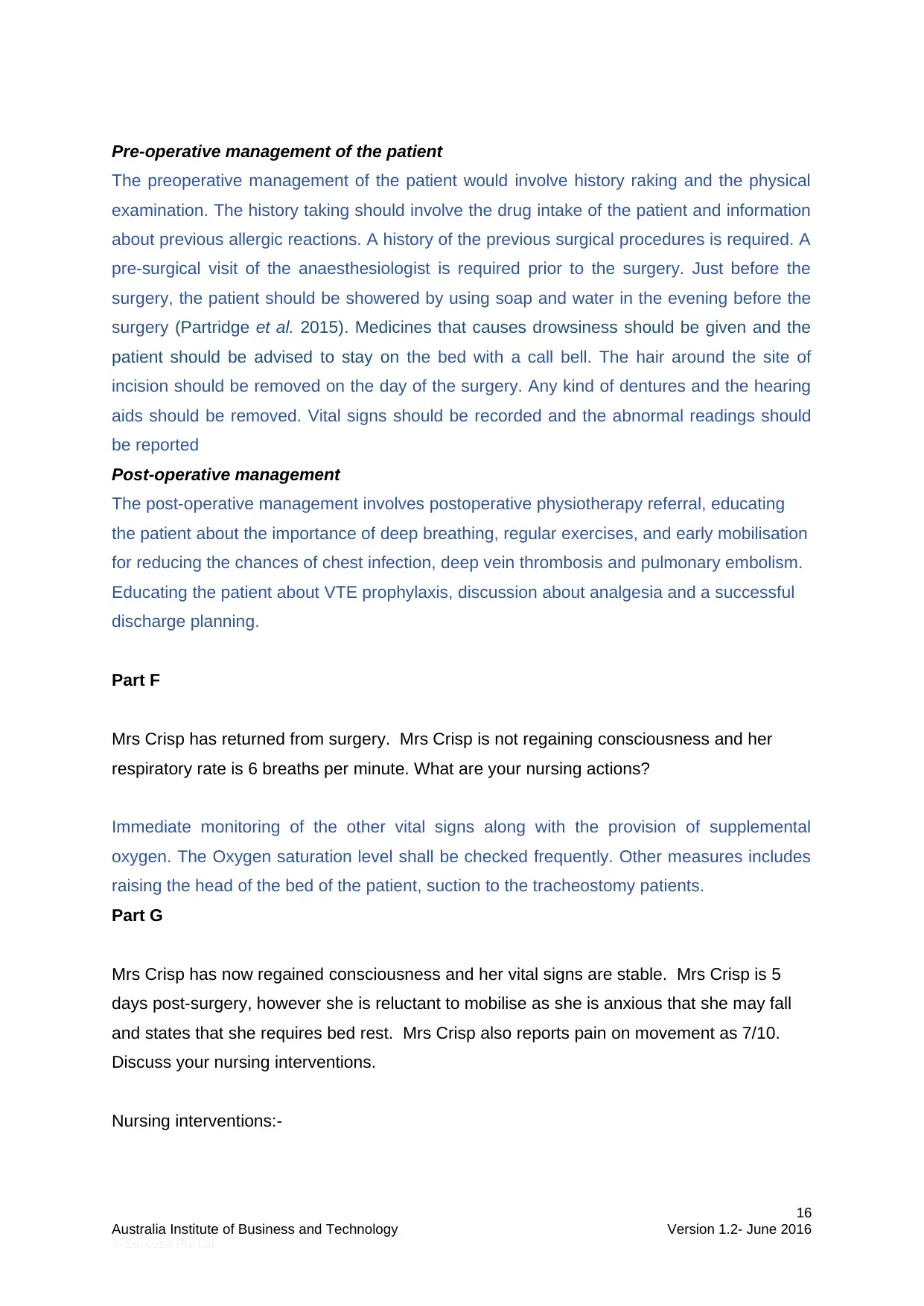
Pre-operative management of the patient
The preoperative management of the patient would involve history raking and the physical
examination. The history taking should involve the drug intake of the patient and information
about previous allergic reactions. A history of the previous surgical procedures is required. A
pre-surgical visit of the anaesthesiologist is required prior to the surgery. Just before the
surgery, the patient should be showered by using soap and water in the evening before the
surgery (Partridge et al. 2015). Medicines that causes drowsiness should be given and the
patient should be advised to stay on the bed with a call bell. The hair around the site of
incision should be removed on the day of the surgery. Any kind of dentures and the hearing
aids should be removed. Vital signs should be recorded and the abnormal readings should
be reported
Post-operative management
The post-operative management involves postoperative physiotherapy referral, educating
the patient about the importance of deep breathing, regular exercises, and early mobilisation
for reducing the chances of chest infection, deep vein thrombosis and pulmonary embolism.
Educating the patient about VTE prophylaxis, discussion about analgesia and a successful
discharge planning.
Part F
Mrs Crisp has returned from surgery. Mrs Crisp is not regaining consciousness and her
respiratory rate is 6 breaths per minute. What are your nursing actions?
Immediate monitoring of the other vital signs along with the provision of supplemental
oxygen. The Oxygen saturation level shall be checked frequently. Other measures includes
raising the head of the bed of the patient, suction to the tracheostomy patients.
Part G
Mrs Crisp has now regained consciousness and her vital signs are stable. Mrs Crisp is 5
days post-surgery, however she is reluctant to mobilise as she is anxious that she may fall
and states that she requires bed rest. Mrs Crisp also reports pain on movement as 7/10.
Discuss your nursing interventions.
Nursing interventions:-
16
Australia Institute of Business and Technology Version 1.2- June 2016
© Succeed Pty Ltd
The preoperative management of the patient would involve history raking and the physical
examination. The history taking should involve the drug intake of the patient and information
about previous allergic reactions. A history of the previous surgical procedures is required. A
pre-surgical visit of the anaesthesiologist is required prior to the surgery. Just before the
surgery, the patient should be showered by using soap and water in the evening before the
surgery (Partridge et al. 2015). Medicines that causes drowsiness should be given and the
patient should be advised to stay on the bed with a call bell. The hair around the site of
incision should be removed on the day of the surgery. Any kind of dentures and the hearing
aids should be removed. Vital signs should be recorded and the abnormal readings should
be reported
Post-operative management
The post-operative management involves postoperative physiotherapy referral, educating
the patient about the importance of deep breathing, regular exercises, and early mobilisation
for reducing the chances of chest infection, deep vein thrombosis and pulmonary embolism.
Educating the patient about VTE prophylaxis, discussion about analgesia and a successful
discharge planning.
Part F
Mrs Crisp has returned from surgery. Mrs Crisp is not regaining consciousness and her
respiratory rate is 6 breaths per minute. What are your nursing actions?
Immediate monitoring of the other vital signs along with the provision of supplemental
oxygen. The Oxygen saturation level shall be checked frequently. Other measures includes
raising the head of the bed of the patient, suction to the tracheostomy patients.
Part G
Mrs Crisp has now regained consciousness and her vital signs are stable. Mrs Crisp is 5
days post-surgery, however she is reluctant to mobilise as she is anxious that she may fall
and states that she requires bed rest. Mrs Crisp also reports pain on movement as 7/10.
Discuss your nursing interventions.
Nursing interventions:-
16
Australia Institute of Business and Technology Version 1.2- June 2016
© Succeed Pty Ltd
Paraphrase This Document
Need a fresh take? Get an instant paraphrase of this document with our AI Paraphraser
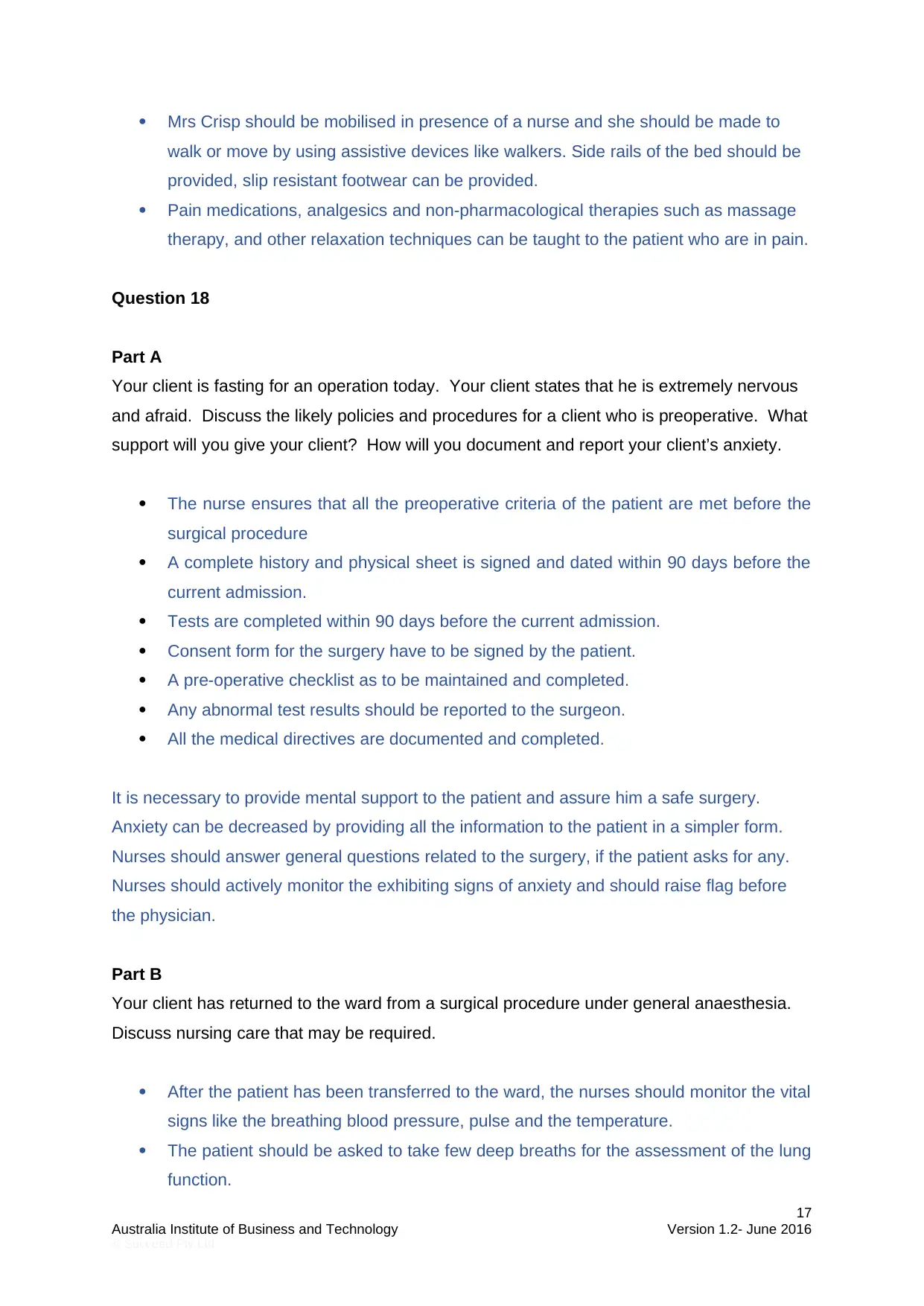
Mrs Crisp should be mobilised in presence of a nurse and she should be made to
walk or move by using assistive devices like walkers. Side rails of the bed should be
provided, slip resistant footwear can be provided.
Pain medications, analgesics and non-pharmacological therapies such as massage
therapy, and other relaxation techniques can be taught to the patient who are in pain.
Question 18
Part A
Your client is fasting for an operation today. Your client states that he is extremely nervous
and afraid. Discuss the likely policies and procedures for a client who is preoperative. What
support will you give your client? How will you document and report your client’s anxiety.
The nurse ensures that all the preoperative criteria of the patient are met before the
surgical procedure
A complete history and physical sheet is signed and dated within 90 days before the
current admission.
Tests are completed within 90 days before the current admission.
Consent form for the surgery have to be signed by the patient.
A pre-operative checklist as to be maintained and completed.
Any abnormal test results should be reported to the surgeon.
All the medical directives are documented and completed.
It is necessary to provide mental support to the patient and assure him a safe surgery.
Anxiety can be decreased by providing all the information to the patient in a simpler form.
Nurses should answer general questions related to the surgery, if the patient asks for any.
Nurses should actively monitor the exhibiting signs of anxiety and should raise flag before
the physician.
Part B
Your client has returned to the ward from a surgical procedure under general anaesthesia.
Discuss nursing care that may be required.
After the patient has been transferred to the ward, the nurses should monitor the vital
signs like the breathing blood pressure, pulse and the temperature.
The patient should be asked to take few deep breaths for the assessment of the lung
function.
17
Australia Institute of Business and Technology Version 1.2- June 2016
© Succeed Pty Ltd
walk or move by using assistive devices like walkers. Side rails of the bed should be
provided, slip resistant footwear can be provided.
Pain medications, analgesics and non-pharmacological therapies such as massage
therapy, and other relaxation techniques can be taught to the patient who are in pain.
Question 18
Part A
Your client is fasting for an operation today. Your client states that he is extremely nervous
and afraid. Discuss the likely policies and procedures for a client who is preoperative. What
support will you give your client? How will you document and report your client’s anxiety.
The nurse ensures that all the preoperative criteria of the patient are met before the
surgical procedure
A complete history and physical sheet is signed and dated within 90 days before the
current admission.
Tests are completed within 90 days before the current admission.
Consent form for the surgery have to be signed by the patient.
A pre-operative checklist as to be maintained and completed.
Any abnormal test results should be reported to the surgeon.
All the medical directives are documented and completed.
It is necessary to provide mental support to the patient and assure him a safe surgery.
Anxiety can be decreased by providing all the information to the patient in a simpler form.
Nurses should answer general questions related to the surgery, if the patient asks for any.
Nurses should actively monitor the exhibiting signs of anxiety and should raise flag before
the physician.
Part B
Your client has returned to the ward from a surgical procedure under general anaesthesia.
Discuss nursing care that may be required.
After the patient has been transferred to the ward, the nurses should monitor the vital
signs like the breathing blood pressure, pulse and the temperature.
The patient should be asked to take few deep breaths for the assessment of the lung
function.
17
Australia Institute of Business and Technology Version 1.2- June 2016
© Succeed Pty Ltd
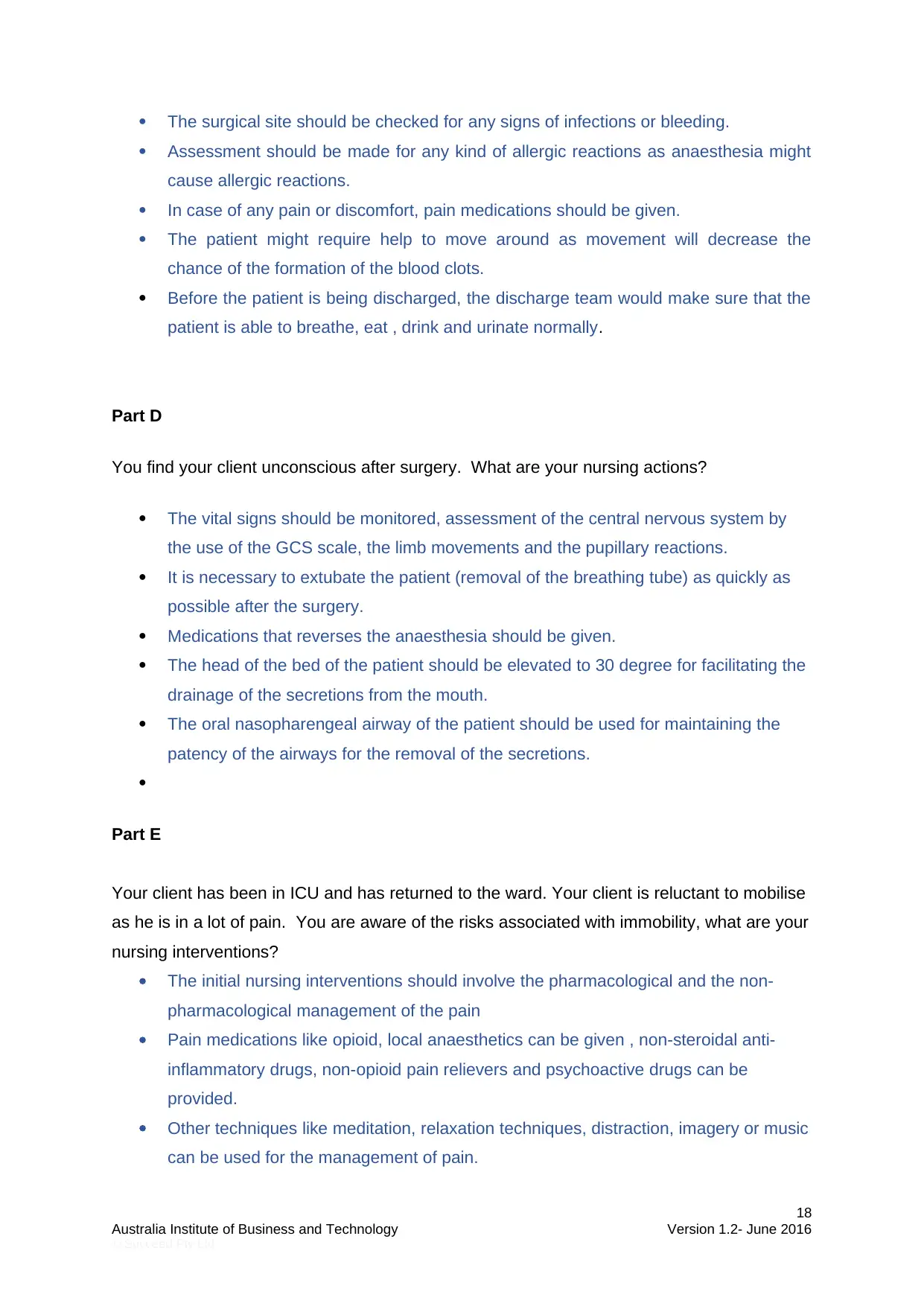
The surgical site should be checked for any signs of infections or bleeding.
Assessment should be made for any kind of allergic reactions as anaesthesia might
cause allergic reactions.
In case of any pain or discomfort, pain medications should be given.
The patient might require help to move around as movement will decrease the
chance of the formation of the blood clots.
Before the patient is being discharged, the discharge team would make sure that the
patient is able to breathe, eat , drink and urinate normally.
Part D
You find your client unconscious after surgery. What are your nursing actions?
The vital signs should be monitored, assessment of the central nervous system by
the use of the GCS scale, the limb movements and the pupillary reactions.
It is necessary to extubate the patient (removal of the breathing tube) as quickly as
possible after the surgery.
Medications that reverses the anaesthesia should be given.
The head of the bed of the patient should be elevated to 30 degree for facilitating the
drainage of the secretions from the mouth.
The oral nasopharengeal airway of the patient should be used for maintaining the
patency of the airways for the removal of the secretions.
Part E
Your client has been in ICU and has returned to the ward. Your client is reluctant to mobilise
as he is in a lot of pain. You are aware of the risks associated with immobility, what are your
nursing interventions?
The initial nursing interventions should involve the pharmacological and the non-
pharmacological management of the pain
Pain medications like opioid, local anaesthetics can be given , non-steroidal anti-
inflammatory drugs, non-opioid pain relievers and psychoactive drugs can be
provided.
Other techniques like meditation, relaxation techniques, distraction, imagery or music
can be used for the management of pain.
18
Australia Institute of Business and Technology Version 1.2- June 2016
© Succeed Pty Ltd
Assessment should be made for any kind of allergic reactions as anaesthesia might
cause allergic reactions.
In case of any pain or discomfort, pain medications should be given.
The patient might require help to move around as movement will decrease the
chance of the formation of the blood clots.
Before the patient is being discharged, the discharge team would make sure that the
patient is able to breathe, eat , drink and urinate normally.
Part D
You find your client unconscious after surgery. What are your nursing actions?
The vital signs should be monitored, assessment of the central nervous system by
the use of the GCS scale, the limb movements and the pupillary reactions.
It is necessary to extubate the patient (removal of the breathing tube) as quickly as
possible after the surgery.
Medications that reverses the anaesthesia should be given.
The head of the bed of the patient should be elevated to 30 degree for facilitating the
drainage of the secretions from the mouth.
The oral nasopharengeal airway of the patient should be used for maintaining the
patency of the airways for the removal of the secretions.
Part E
Your client has been in ICU and has returned to the ward. Your client is reluctant to mobilise
as he is in a lot of pain. You are aware of the risks associated with immobility, what are your
nursing interventions?
The initial nursing interventions should involve the pharmacological and the non-
pharmacological management of the pain
Pain medications like opioid, local anaesthetics can be given , non-steroidal anti-
inflammatory drugs, non-opioid pain relievers and psychoactive drugs can be
provided.
Other techniques like meditation, relaxation techniques, distraction, imagery or music
can be used for the management of pain.
18
Australia Institute of Business and Technology Version 1.2- June 2016
© Succeed Pty Ltd

The client should be positioned in the best ways possible, where the patient
experiences less pain.
Assistive devices can be provided to aid the patient to mobilise.
Question 19
Early recognition of deterioration and timely intervention are crucial to good outcomes in
critical illness. It was once typical for in-hospital emergency response teams to be activated
only in the event of a patient suffering cardiac arrest. Research has shown that many
cardiac arrests are preceded by clear signs of deterioration and can potentially be
prevented. The MET system aims is to identify seriously ill patients early to allow intervention
before a cardiac arrest takes place. This is achieved by using a set of calling criteria that all
staff are familiar with. The criteria are physiologic changes in a patient’s condition and if any
of the criteria are met an emergency response is triggered and the MET assesses the
patient. The MET team usually consists of an Intensive Care doctor, a senior Intensive Care
nurse and a Medical Registrar who have the advanced resuscitation skills necessary to
respond to a medical emergency. The team is usually available to 24-hours, seven-days-a-
week. The effectiveness of the MET system is continuously monitored through the use of
outcome indicators.
Part A
When would you call a MET (Code Blue)?
Code blue is generally called for a patient who requires resuscitation due to a respiratory or
a cardiac arrest.
Part B
What is your role after you have called a MET for a patient who is unresponsive, has no
pulse or respirations?
If the one is trained then Cardiopulmonary resuscitation (CPR) is the most important life
saving techniques. If no pulse or breathing is observed within 10 seconds then chest
compression should be started – 30 chest compressions before giving two rescue breaths.
After 30 chest compressions, the airways should be opened by tilting the head of the person.
Rescue breathing can be given mouth to mouth or mouth to nose (Smith et al. 2013).
_________________________________________________________________________
19
Australia Institute of Business and Technology Version 1.2- June 2016
© Succeed Pty Ltd
experiences less pain.
Assistive devices can be provided to aid the patient to mobilise.
Question 19
Early recognition of deterioration and timely intervention are crucial to good outcomes in
critical illness. It was once typical for in-hospital emergency response teams to be activated
only in the event of a patient suffering cardiac arrest. Research has shown that many
cardiac arrests are preceded by clear signs of deterioration and can potentially be
prevented. The MET system aims is to identify seriously ill patients early to allow intervention
before a cardiac arrest takes place. This is achieved by using a set of calling criteria that all
staff are familiar with. The criteria are physiologic changes in a patient’s condition and if any
of the criteria are met an emergency response is triggered and the MET assesses the
patient. The MET team usually consists of an Intensive Care doctor, a senior Intensive Care
nurse and a Medical Registrar who have the advanced resuscitation skills necessary to
respond to a medical emergency. The team is usually available to 24-hours, seven-days-a-
week. The effectiveness of the MET system is continuously monitored through the use of
outcome indicators.
Part A
When would you call a MET (Code Blue)?
Code blue is generally called for a patient who requires resuscitation due to a respiratory or
a cardiac arrest.
Part B
What is your role after you have called a MET for a patient who is unresponsive, has no
pulse or respirations?
If the one is trained then Cardiopulmonary resuscitation (CPR) is the most important life
saving techniques. If no pulse or breathing is observed within 10 seconds then chest
compression should be started – 30 chest compressions before giving two rescue breaths.
After 30 chest compressions, the airways should be opened by tilting the head of the person.
Rescue breathing can be given mouth to mouth or mouth to nose (Smith et al. 2013).
_________________________________________________________________________
19
Australia Institute of Business and Technology Version 1.2- June 2016
© Succeed Pty Ltd
Secure Best Marks with AI Grader
Need help grading? Try our AI Grader for instant feedback on your assignments.
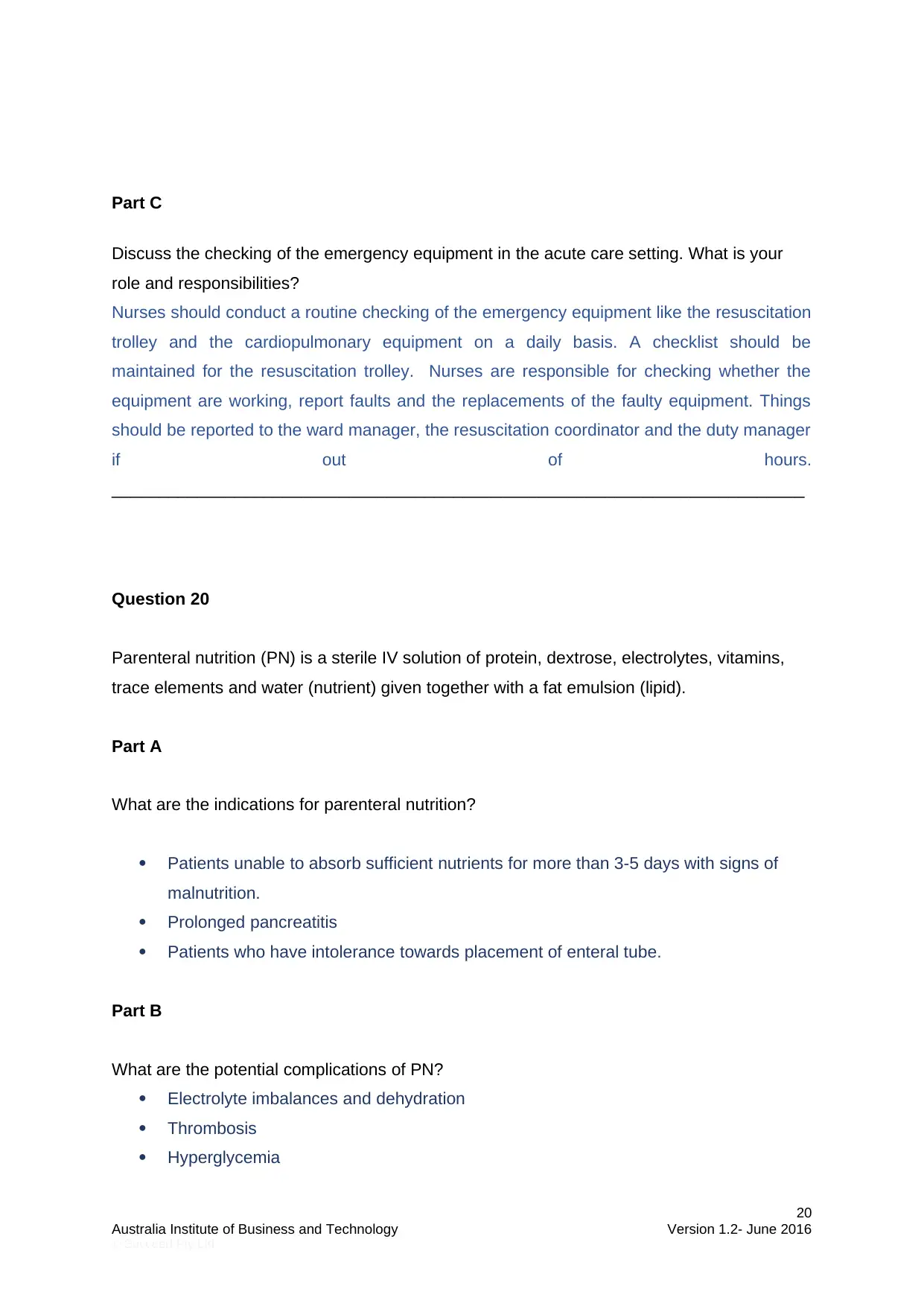
Part C
Discuss the checking of the emergency equipment in the acute care setting. What is your
role and responsibilities?
Nurses should conduct a routine checking of the emergency equipment like the resuscitation
trolley and the cardiopulmonary equipment on a daily basis. A checklist should be
maintained for the resuscitation trolley. Nurses are responsible for checking whether the
equipment are working, report faults and the replacements of the faulty equipment. Things
should be reported to the ward manager, the resuscitation coordinator and the duty manager
if out of hours.
_________________________________________________________________________
Question 20
Parenteral nutrition (PN) is a sterile IV solution of protein, dextrose, electrolytes, vitamins,
trace elements and water (nutrient) given together with a fat emulsion (lipid).
Part A
What are the indications for parenteral nutrition?
Patients unable to absorb sufficient nutrients for more than 3-5 days with signs of
malnutrition.
Prolonged pancreatitis
Patients who have intolerance towards placement of enteral tube.
Part B
What are the potential complications of PN?
Electrolyte imbalances and dehydration
Thrombosis
Hyperglycemia
20
Australia Institute of Business and Technology Version 1.2- June 2016
© Succeed Pty Ltd
Discuss the checking of the emergency equipment in the acute care setting. What is your
role and responsibilities?
Nurses should conduct a routine checking of the emergency equipment like the resuscitation
trolley and the cardiopulmonary equipment on a daily basis. A checklist should be
maintained for the resuscitation trolley. Nurses are responsible for checking whether the
equipment are working, report faults and the replacements of the faulty equipment. Things
should be reported to the ward manager, the resuscitation coordinator and the duty manager
if out of hours.
_________________________________________________________________________
Question 20
Parenteral nutrition (PN) is a sterile IV solution of protein, dextrose, electrolytes, vitamins,
trace elements and water (nutrient) given together with a fat emulsion (lipid).
Part A
What are the indications for parenteral nutrition?
Patients unable to absorb sufficient nutrients for more than 3-5 days with signs of
malnutrition.
Prolonged pancreatitis
Patients who have intolerance towards placement of enteral tube.
Part B
What are the potential complications of PN?
Electrolyte imbalances and dehydration
Thrombosis
Hyperglycemia
20
Australia Institute of Business and Technology Version 1.2- June 2016
© Succeed Pty Ltd
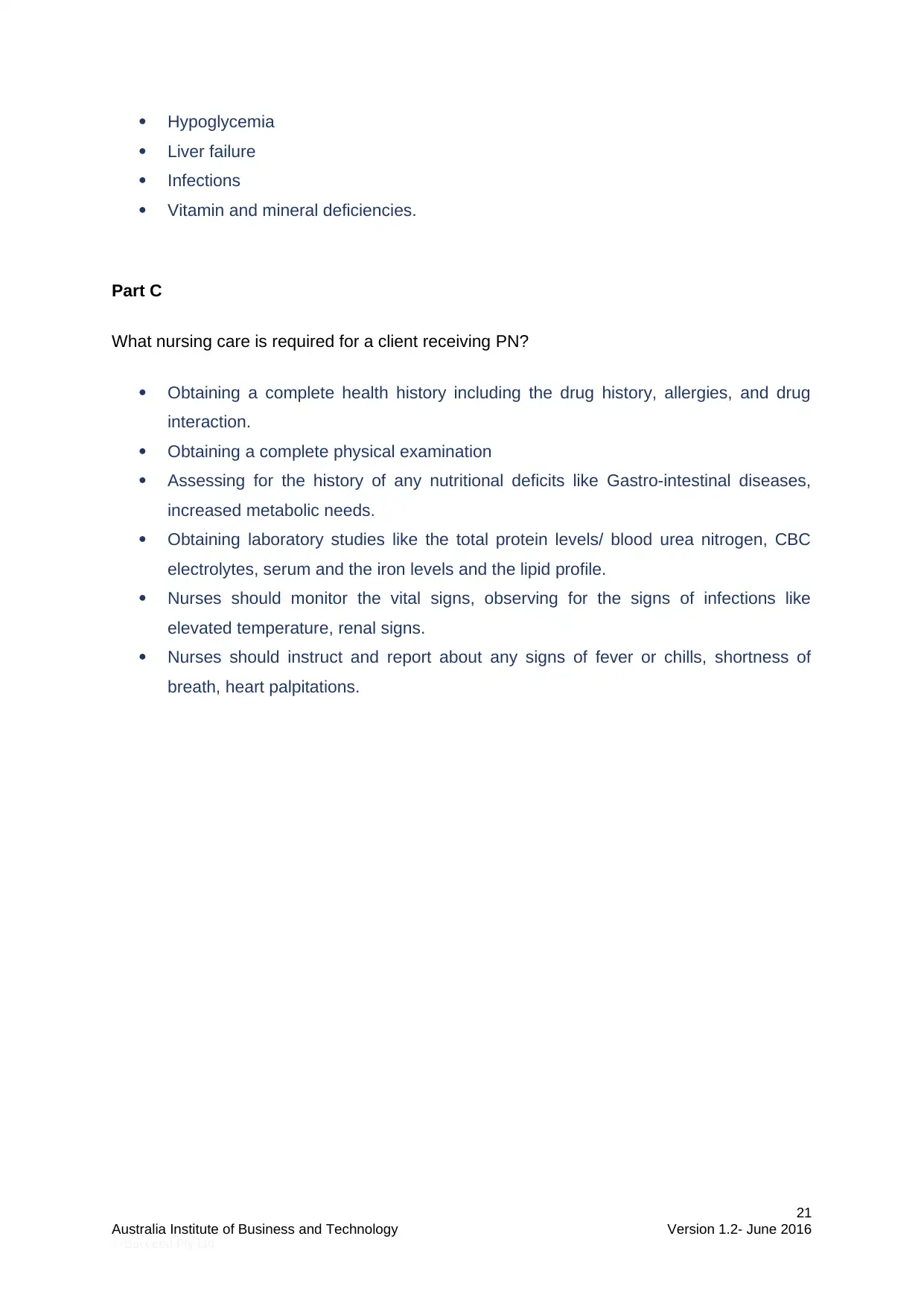
Hypoglycemia
Liver failure
Infections
Vitamin and mineral deficiencies.
Part C
What nursing care is required for a client receiving PN?
Obtaining a complete health history including the drug history, allergies, and drug
interaction.
Obtaining a complete physical examination
Assessing for the history of any nutritional deficits like Gastro-intestinal diseases,
increased metabolic needs.
Obtaining laboratory studies like the total protein levels/ blood urea nitrogen, CBC
electrolytes, serum and the iron levels and the lipid profile.
Nurses should monitor the vital signs, observing for the signs of infections like
elevated temperature, renal signs.
Nurses should instruct and report about any signs of fever or chills, shortness of
breath, heart palpitations.
21
Australia Institute of Business and Technology Version 1.2- June 2016
© Succeed Pty Ltd
Liver failure
Infections
Vitamin and mineral deficiencies.
Part C
What nursing care is required for a client receiving PN?
Obtaining a complete health history including the drug history, allergies, and drug
interaction.
Obtaining a complete physical examination
Assessing for the history of any nutritional deficits like Gastro-intestinal diseases,
increased metabolic needs.
Obtaining laboratory studies like the total protein levels/ blood urea nitrogen, CBC
electrolytes, serum and the iron levels and the lipid profile.
Nurses should monitor the vital signs, observing for the signs of infections like
elevated temperature, renal signs.
Nurses should instruct and report about any signs of fever or chills, shortness of
breath, heart palpitations.
21
Australia Institute of Business and Technology Version 1.2- June 2016
© Succeed Pty Ltd
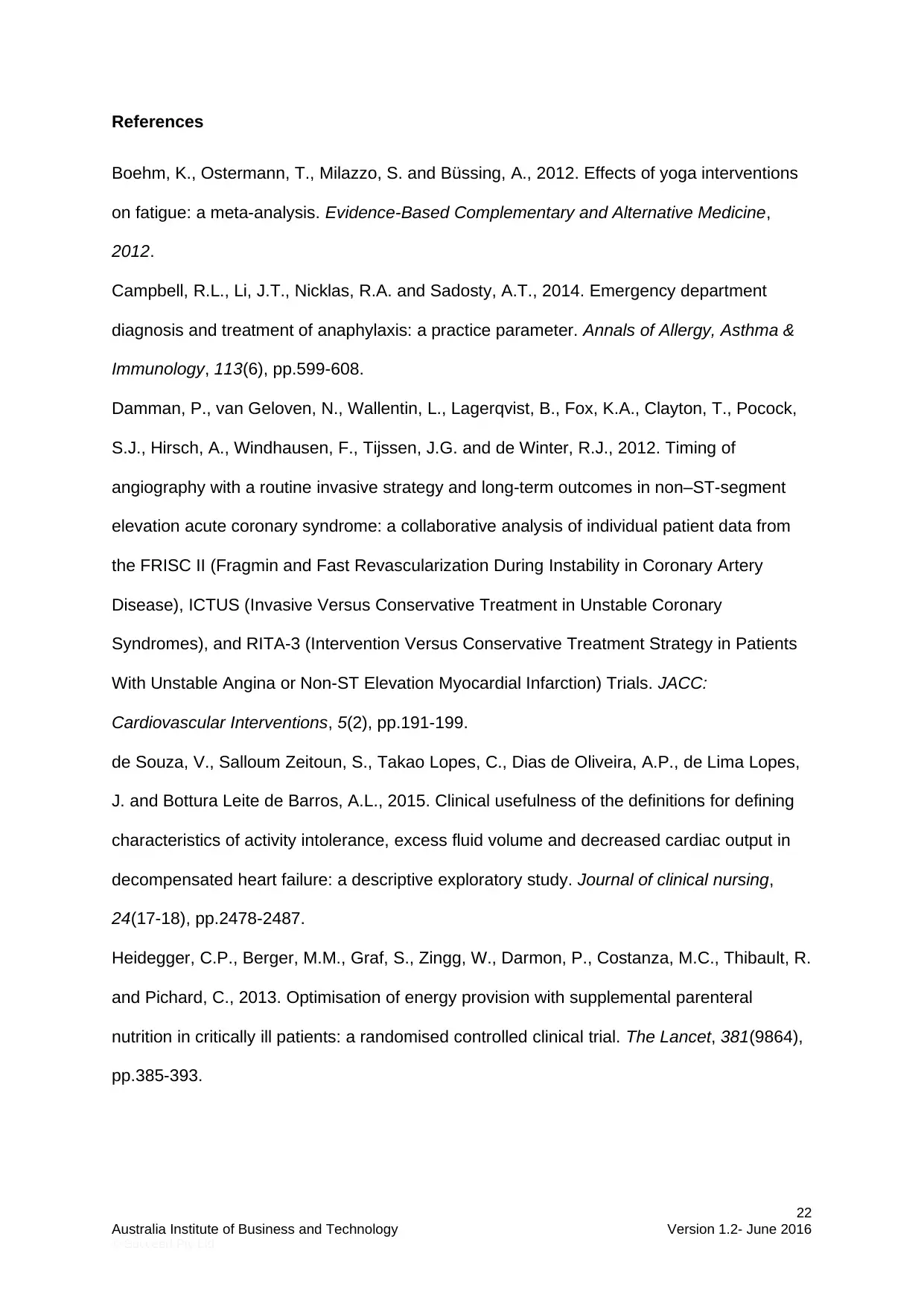
References
Boehm, K., Ostermann, T., Milazzo, S. and Büssing, A., 2012. Effects of yoga interventions
on fatigue: a meta-analysis. Evidence-Based Complementary and Alternative Medicine,
2012.
Campbell, R.L., Li, J.T., Nicklas, R.A. and Sadosty, A.T., 2014. Emergency department
diagnosis and treatment of anaphylaxis: a practice parameter. Annals of Allergy, Asthma &
Immunology, 113(6), pp.599-608.
Damman, P., van Geloven, N., Wallentin, L., Lagerqvist, B., Fox, K.A., Clayton, T., Pocock,
S.J., Hirsch, A., Windhausen, F., Tijssen, J.G. and de Winter, R.J., 2012. Timing of
angiography with a routine invasive strategy and long-term outcomes in non–ST-segment
elevation acute coronary syndrome: a collaborative analysis of individual patient data from
the FRISC II (Fragmin and Fast Revascularization During Instability in Coronary Artery
Disease), ICTUS (Invasive Versus Conservative Treatment in Unstable Coronary
Syndromes), and RITA-3 (Intervention Versus Conservative Treatment Strategy in Patients
With Unstable Angina or Non-ST Elevation Myocardial Infarction) Trials. JACC:
Cardiovascular Interventions, 5(2), pp.191-199.
de Souza, V., Salloum Zeitoun, S., Takao Lopes, C., Dias de Oliveira, A.P., de Lima Lopes,
J. and Bottura Leite de Barros, A.L., 2015. Clinical usefulness of the definitions for defining
characteristics of activity intolerance, excess fluid volume and decreased cardiac output in
decompensated heart failure: a descriptive exploratory study. Journal of clinical nursing,
24(17-18), pp.2478-2487.
Heidegger, C.P., Berger, M.M., Graf, S., Zingg, W., Darmon, P., Costanza, M.C., Thibault, R.
and Pichard, C., 2013. Optimisation of energy provision with supplemental parenteral
nutrition in critically ill patients: a randomised controlled clinical trial. The Lancet, 381(9864),
pp.385-393.
22
Australia Institute of Business and Technology Version 1.2- June 2016
© Succeed Pty Ltd
Boehm, K., Ostermann, T., Milazzo, S. and Büssing, A., 2012. Effects of yoga interventions
on fatigue: a meta-analysis. Evidence-Based Complementary and Alternative Medicine,
2012.
Campbell, R.L., Li, J.T., Nicklas, R.A. and Sadosty, A.T., 2014. Emergency department
diagnosis and treatment of anaphylaxis: a practice parameter. Annals of Allergy, Asthma &
Immunology, 113(6), pp.599-608.
Damman, P., van Geloven, N., Wallentin, L., Lagerqvist, B., Fox, K.A., Clayton, T., Pocock,
S.J., Hirsch, A., Windhausen, F., Tijssen, J.G. and de Winter, R.J., 2012. Timing of
angiography with a routine invasive strategy and long-term outcomes in non–ST-segment
elevation acute coronary syndrome: a collaborative analysis of individual patient data from
the FRISC II (Fragmin and Fast Revascularization During Instability in Coronary Artery
Disease), ICTUS (Invasive Versus Conservative Treatment in Unstable Coronary
Syndromes), and RITA-3 (Intervention Versus Conservative Treatment Strategy in Patients
With Unstable Angina or Non-ST Elevation Myocardial Infarction) Trials. JACC:
Cardiovascular Interventions, 5(2), pp.191-199.
de Souza, V., Salloum Zeitoun, S., Takao Lopes, C., Dias de Oliveira, A.P., de Lima Lopes,
J. and Bottura Leite de Barros, A.L., 2015. Clinical usefulness of the definitions for defining
characteristics of activity intolerance, excess fluid volume and decreased cardiac output in
decompensated heart failure: a descriptive exploratory study. Journal of clinical nursing,
24(17-18), pp.2478-2487.
Heidegger, C.P., Berger, M.M., Graf, S., Zingg, W., Darmon, P., Costanza, M.C., Thibault, R.
and Pichard, C., 2013. Optimisation of energy provision with supplemental parenteral
nutrition in critically ill patients: a randomised controlled clinical trial. The Lancet, 381(9864),
pp.385-393.
22
Australia Institute of Business and Technology Version 1.2- June 2016
© Succeed Pty Ltd
Paraphrase This Document
Need a fresh take? Get an instant paraphrase of this document with our AI Paraphraser
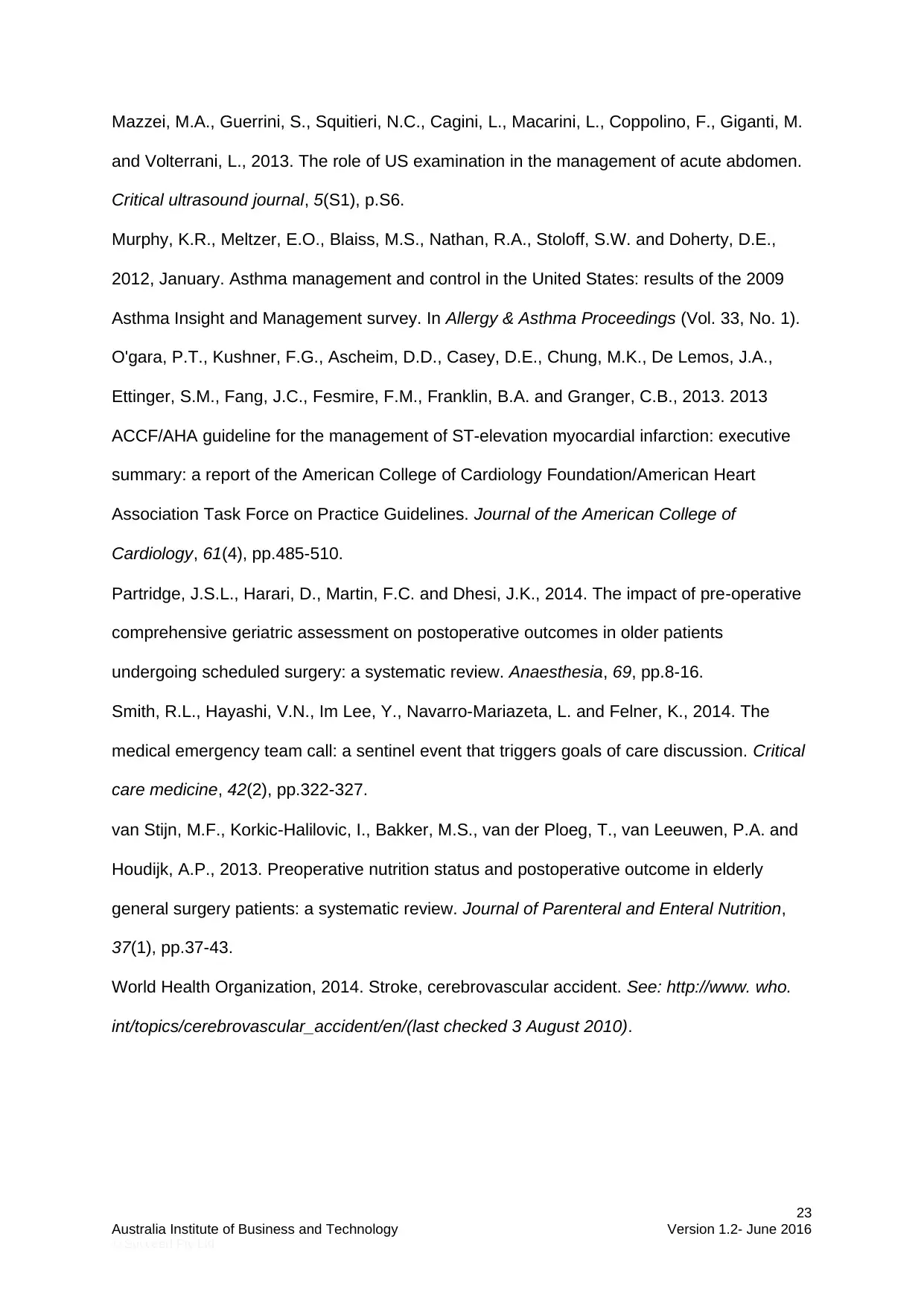
Mazzei, M.A., Guerrini, S., Squitieri, N.C., Cagini, L., Macarini, L., Coppolino, F., Giganti, M.
and Volterrani, L., 2013. The role of US examination in the management of acute abdomen.
Critical ultrasound journal, 5(S1), p.S6.
Murphy, K.R., Meltzer, E.O., Blaiss, M.S., Nathan, R.A., Stoloff, S.W. and Doherty, D.E.,
2012, January. Asthma management and control in the United States: results of the 2009
Asthma Insight and Management survey. In Allergy & Asthma Proceedings (Vol. 33, No. 1).
O'gara, P.T., Kushner, F.G., Ascheim, D.D., Casey, D.E., Chung, M.K., De Lemos, J.A.,
Ettinger, S.M., Fang, J.C., Fesmire, F.M., Franklin, B.A. and Granger, C.B., 2013. 2013
ACCF/AHA guideline for the management of ST-elevation myocardial infarction: executive
summary: a report of the American College of Cardiology Foundation/American Heart
Association Task Force on Practice Guidelines. Journal of the American College of
Cardiology, 61(4), pp.485-510.
Partridge, J.S.L., Harari, D., Martin, F.C. and Dhesi, J.K., 2014. The impact of pre‐operative
comprehensive geriatric assessment on postoperative outcomes in older patients
undergoing scheduled surgery: a systematic review. Anaesthesia, 69, pp.8-16.
Smith, R.L., Hayashi, V.N., Im Lee, Y., Navarro-Mariazeta, L. and Felner, K., 2014. The
medical emergency team call: a sentinel event that triggers goals of care discussion. Critical
care medicine, 42(2), pp.322-327.
van Stijn, M.F., Korkic‐Halilovic, I., Bakker, M.S., van der Ploeg, T., van Leeuwen, P.A. and
Houdijk, A.P., 2013. Preoperative nutrition status and postoperative outcome in elderly
general surgery patients: a systematic review. Journal of Parenteral and Enteral Nutrition,
37(1), pp.37-43.
World Health Organization, 2014. Stroke, cerebrovascular accident. See: http://www. who.
int/topics/cerebrovascular_accident/en/(last checked 3 August 2010).
23
Australia Institute of Business and Technology Version 1.2- June 2016
© Succeed Pty Ltd
and Volterrani, L., 2013. The role of US examination in the management of acute abdomen.
Critical ultrasound journal, 5(S1), p.S6.
Murphy, K.R., Meltzer, E.O., Blaiss, M.S., Nathan, R.A., Stoloff, S.W. and Doherty, D.E.,
2012, January. Asthma management and control in the United States: results of the 2009
Asthma Insight and Management survey. In Allergy & Asthma Proceedings (Vol. 33, No. 1).
O'gara, P.T., Kushner, F.G., Ascheim, D.D., Casey, D.E., Chung, M.K., De Lemos, J.A.,
Ettinger, S.M., Fang, J.C., Fesmire, F.M., Franklin, B.A. and Granger, C.B., 2013. 2013
ACCF/AHA guideline for the management of ST-elevation myocardial infarction: executive
summary: a report of the American College of Cardiology Foundation/American Heart
Association Task Force on Practice Guidelines. Journal of the American College of
Cardiology, 61(4), pp.485-510.
Partridge, J.S.L., Harari, D., Martin, F.C. and Dhesi, J.K., 2014. The impact of pre‐operative
comprehensive geriatric assessment on postoperative outcomes in older patients
undergoing scheduled surgery: a systematic review. Anaesthesia, 69, pp.8-16.
Smith, R.L., Hayashi, V.N., Im Lee, Y., Navarro-Mariazeta, L. and Felner, K., 2014. The
medical emergency team call: a sentinel event that triggers goals of care discussion. Critical
care medicine, 42(2), pp.322-327.
van Stijn, M.F., Korkic‐Halilovic, I., Bakker, M.S., van der Ploeg, T., van Leeuwen, P.A. and
Houdijk, A.P., 2013. Preoperative nutrition status and postoperative outcome in elderly
general surgery patients: a systematic review. Journal of Parenteral and Enteral Nutrition,
37(1), pp.37-43.
World Health Organization, 2014. Stroke, cerebrovascular accident. See: http://www. who.
int/topics/cerebrovascular_accident/en/(last checked 3 August 2010).
23
Australia Institute of Business and Technology Version 1.2- June 2016
© Succeed Pty Ltd
1 out of 23
Related Documents
Your All-in-One AI-Powered Toolkit for Academic Success.
+13062052269
info@desklib.com
Available 24*7 on WhatsApp / Email
![[object Object]](/_next/static/media/star-bottom.7253800d.svg)
Unlock your academic potential
© 2024 | Zucol Services PVT LTD | All rights reserved.




